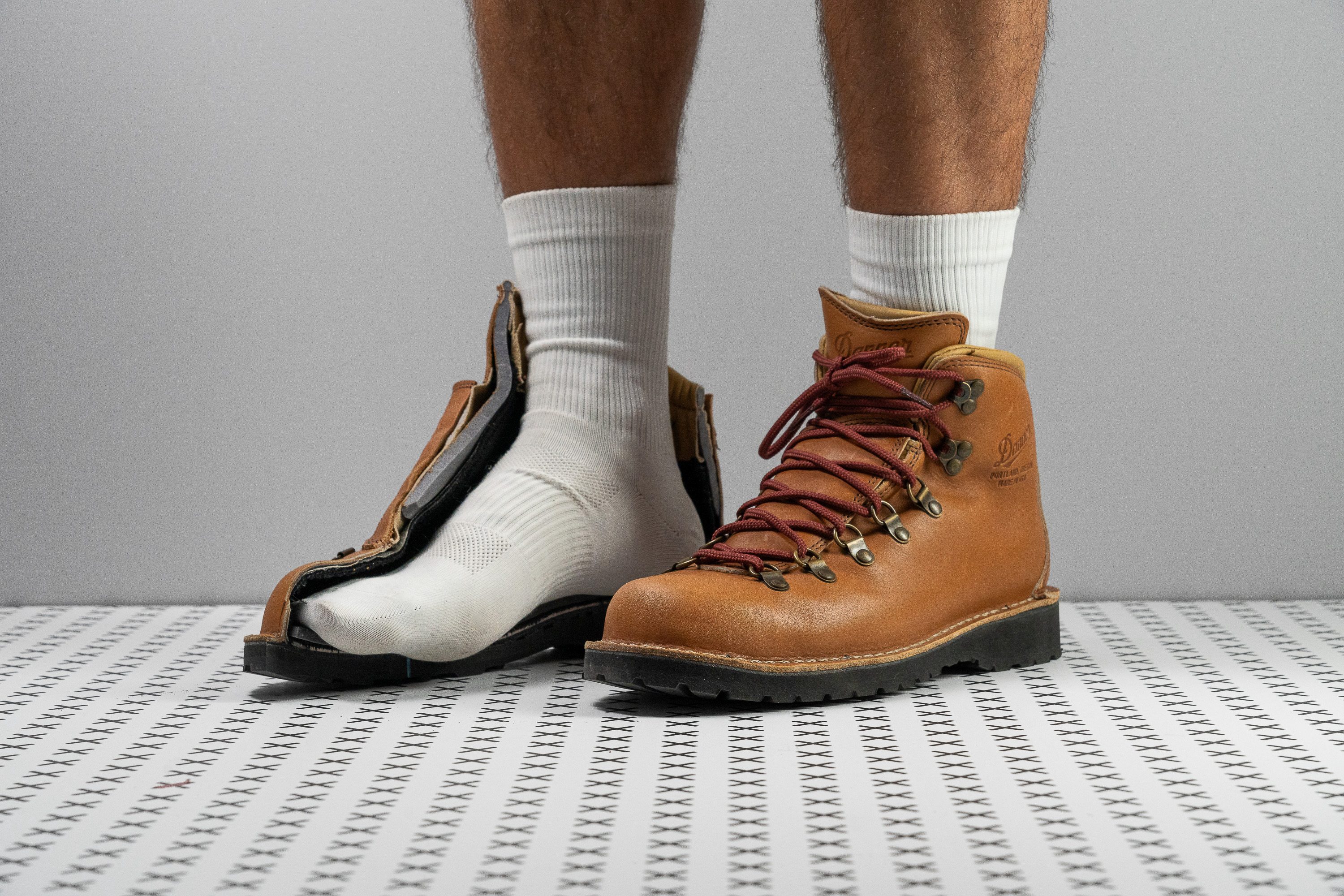Nuestra conclusión
Pros
- Calidad y diseño excepcionales (fabricadas en Estados Unidos)
- Estructura resistente y duradera
- Te las puedes poner durante todo el año
- Protegen mucho los pies
- Sujetan muy bien los pies
- Plataforma muy estable
- Se puede cambiar su suela y rehacerlas
- Atractivo vintage difícil de superar
Contras
- Caras no, carísimas
- No son aptas para el senderismo serio o los terrenos difíciles
- Mucho más pesadas que la media
- Parte delantera estrecha
Veredicto de los usuarios
- Top 8% entre botas de senderismo
- Top 20% entre botas de senderismo Danner
Comparativa
Las botas de senderismo más parecidas
+ + Añadir unas zapatillas | |||||
|---|---|---|---|---|---|
| Puntuación global | 91 Excelentes | 90 Notables | 83 Buenas | 90 Notables | |
| Precio | 440 € | 210 € | 170 € | 200 € | |
| Terreno de trail | SencilloModerado | SencilloModerado | Moderado | SencilloModerado | |
| Absorción de impactos | - | Baja | Baja | Alta | |
| Retorno de energía | - | Bajo | Alto | Alto | |
| Peso laboratorio Peso marca | 23.7 oz / 672g 23 oz / 652g | 17 oz / 482g 17 oz / 482g | 18.1 oz / 513g 17.1 oz / 485g | 15 oz / 425g 15 oz / 425g | |
| Lightweight | ✗ | ✓ | ✗ | ✓ | |
| Transpirabilidad | Baja | Baja | Media | Alta | |
| Uso | Senderismo ligeroSenderismo urbano | Senderismo de un díaSenderismo ligeroSenderismo urbano | Senderismo ligeroSenderismo urbanoPara principiantes | Senderismo de un díaSenderismo rápidoSenderismo ligero | |
| Orthotic friendly | ✓ | ✓ | ✓ | ✓ | |
| Drop laboratorio | 17.5 mm | 13.5 mm | 14.0 mm | 14.4 mm | |
| Talla | Tallan bien | Tallan bien | Tallan bien | Tallan bien | |
| Rigidez de la mediasuela | Firme | Firme | Firme | Blanda | |
| Diferencia de la rigidez de la mediasuela en frío | Pequeña | Pequeña | Pequeña | Grande | |
| Rigidez del contrafuerte del talón | Flexible | Firme | Flexible | Flexible | |
| Flexibilidad | Rígida | Moderada | Moderada | Flexible | |
| Dureza de la suela | Dura | Muy dura | Blanda | Muy blanda | |
| Impermeabilización | - | Impermeables | - | - | |
| Material | Piel o cuero | Ante | Piel o cuero | KnitMalla | |
| Estación | Invierno | Invierno | Todas las estaciones | VeranoTodas las estaciones | |
| Durabilidad de la parte delantera | Buena | Decente | - | Decente | |
| Durabilidad del acolchado del talón | Alta | Media | - | Alta | |
| Durabilidad de la suela exterior | Decente | Decente | - | Buena | |
| Anchura / ajuste | Media | Media | Estrecha | Ancha | |
| Anchura de la parte delantera | Estrecha | Media | Estrecha | Media | |
| Profundidad del dibujo de la suela | 3.1 mm | 3.7 mm | 3.4 mm | 3.7 mm | |
| Altura de la suela en la zona del talón laboratorio | 41.3 mm | 32.7 mm | 34.6 mm | 38.4 mm | |
| Antepié | 23.8 mm | 19.2 mm | 20.6 mm | 24.0 mm | |
| Anchuras disponibles | Estándar | Estándar | EstándarAncho | Estándar | |
| Tecnología | OrtholiteVibram | Ortholite | Ortholite | - | |
| Cut | Corte alto | Corte medio | Corte medio | Corte medio | |
| Removable insole | ✓ | ✓ | ✓ | ✓ | |
| Clasificación | #3 Top 8% | #8 Top 20% | #30 26% inferior | #6 Top 15% | |
| Popularidad | #19 Top 47% | #32 21% inferior | #10 Top 25% | #14 Top 35% |
Quién debería comprárselas
Creemos que las Danner Mountain Pass son una apuesta segura si estás a la caza de:
- Unas botas retro con una estética tipo leñador y unos cordones que van del cuello a la zona de los dedos.
- Unas botas elegantes que harán que estés en tu salsa tanto en la naturaleza como en la ciudad.
- Un modelo fabricado en Estados Unidos que tenga cuero de calidad premium y un diseño de primera.
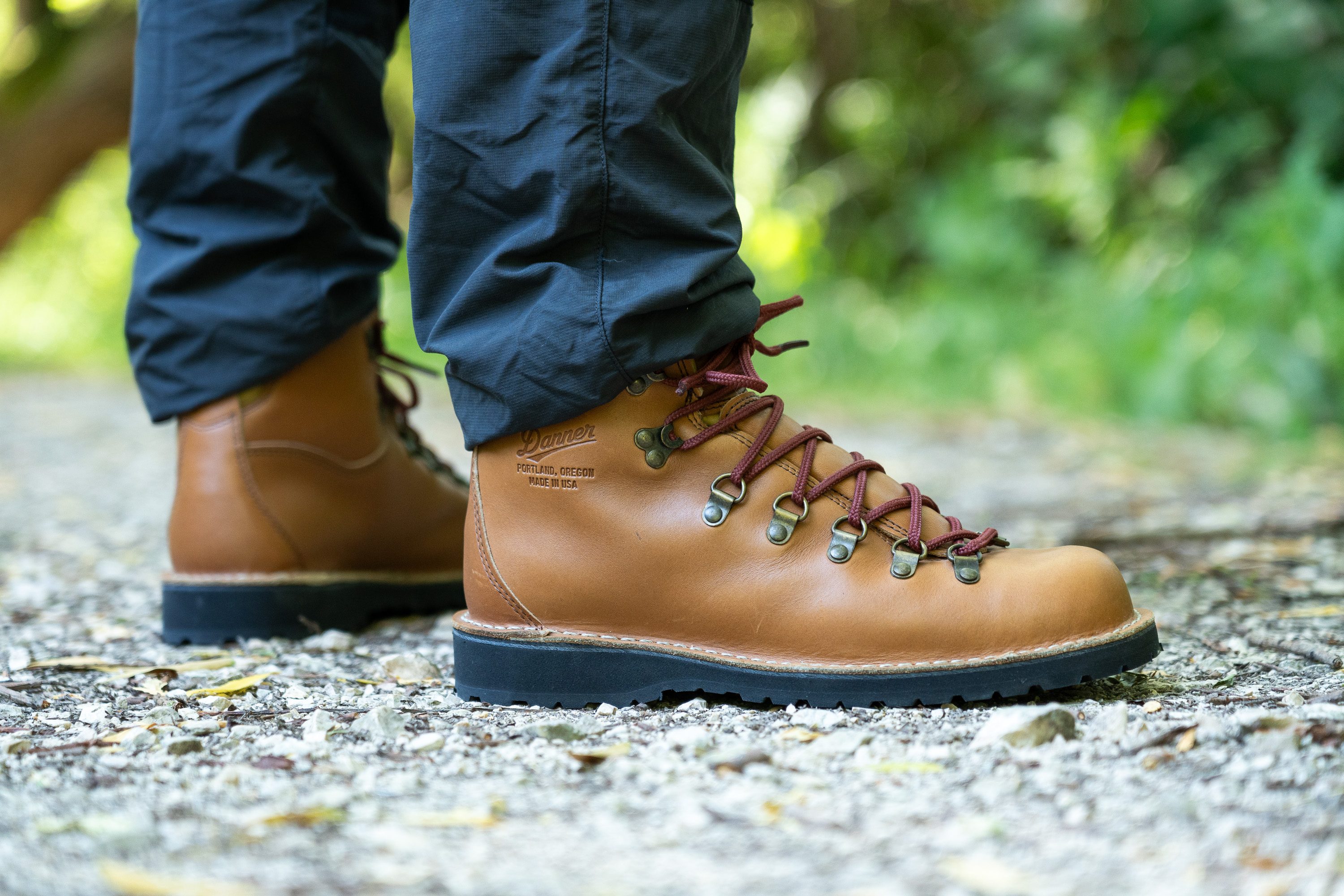
Quién NO debería comprárselas
El precio de las Mountain Pass puede ser lo que haga que la gente decida comprárselas o no, sobre todo si estás buscando unas botas de senderismo funcionales.
Para el trekking en terrenos técnicos, creemos que estarás mucho más contentos con las Scarpa Terra GTX o con las Lowa Renegade GTX Mid. Ambas opciones son más baratas, ligeras y prácticas que las Mountain Pass a la hora de irse de ruta.
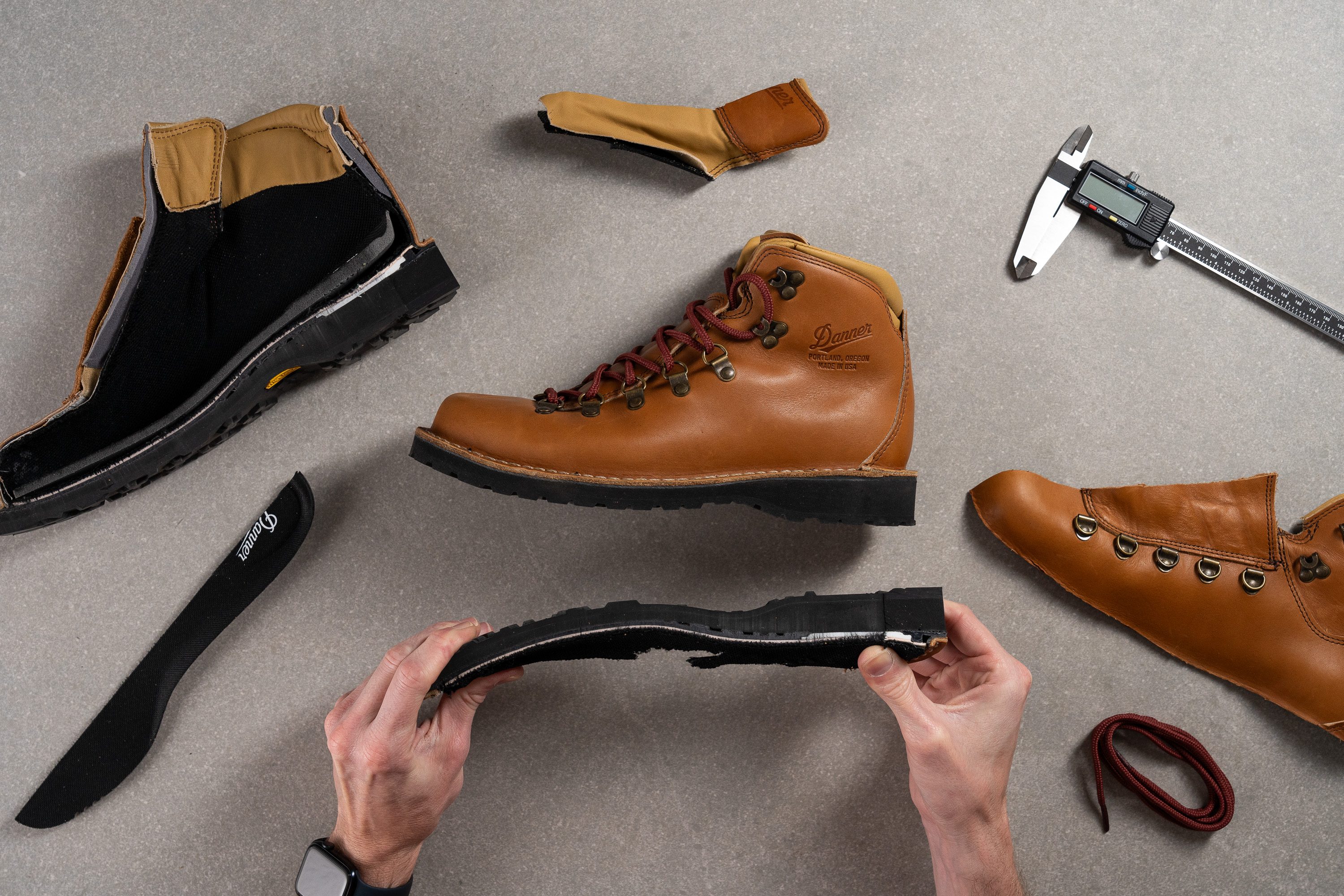
Para las excursiones menos exigentes, tienes las Danner Mountain 600, o también puedes echarle un ojo a nuestras opciones favoritas para senderismo de un día.
Amortiguación
Altura de la suela en la zona del talón
Con solo echarle un ojo, la suela de las Mountain Pass ya parece ser más grande que la media.
Cuando la medimos con nuestro calibre, vimos que medía lo mismo que la de las Mountain Light: 41,3 mm.

Como tienen tanto caucho y espuma, nos protegieron de los obstáculos del trail. Casi no sentimos ni las rocas ni las raíces que pisamos con estas botas.
| Mountain Pass | 41.3 mm |
| Media | 36.3 mm |
Altura de la suela en el antepié
La suela de las Mountain Pass en el antepié está bastante cerca de la media.
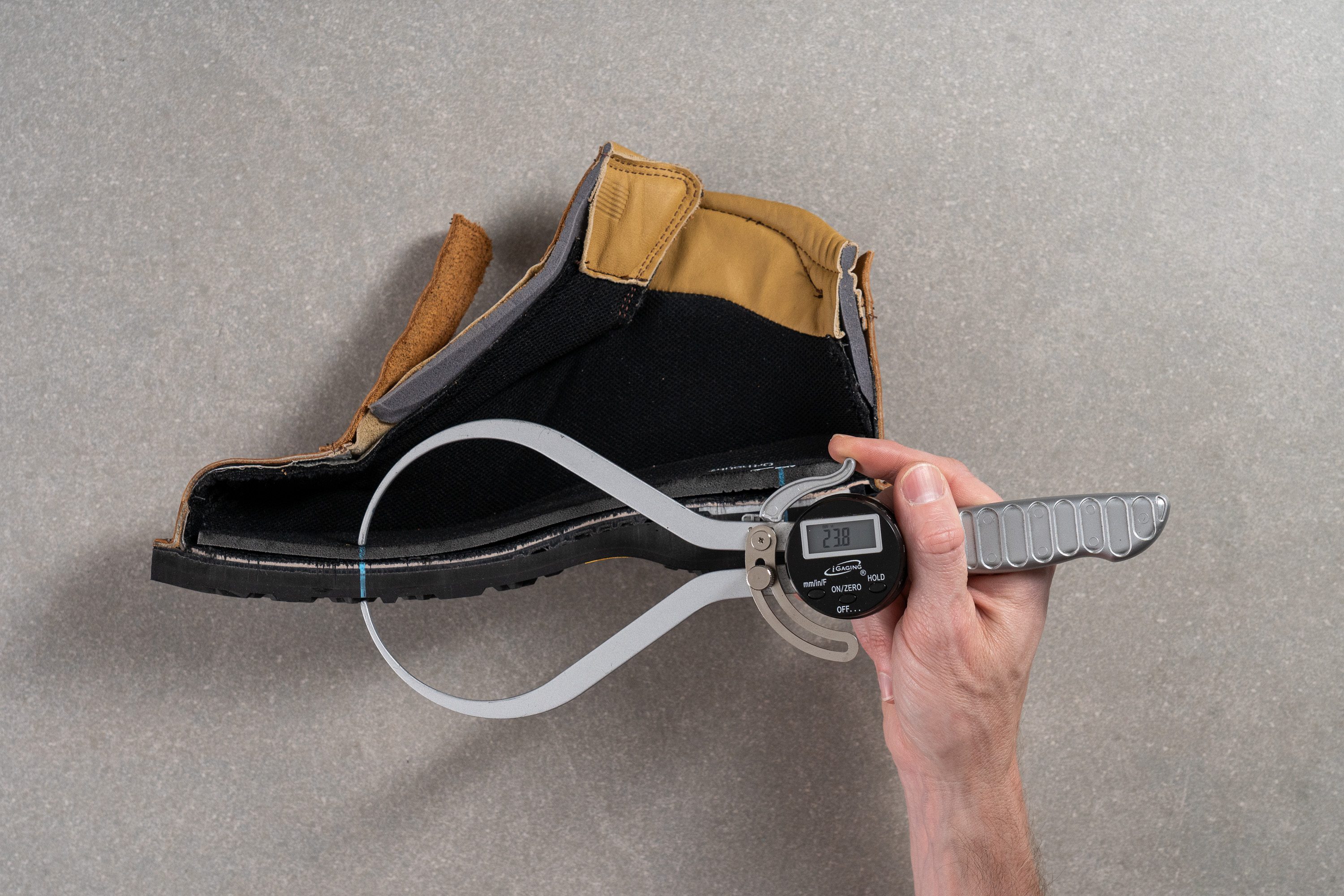
Con sus 23,8 mm, es un poco más baja que la de las Mountain Light (26,0 mm). Pero, al poner las dos botas una al lado de la otra, parece que la diferencia es de más de un par de milímetros.
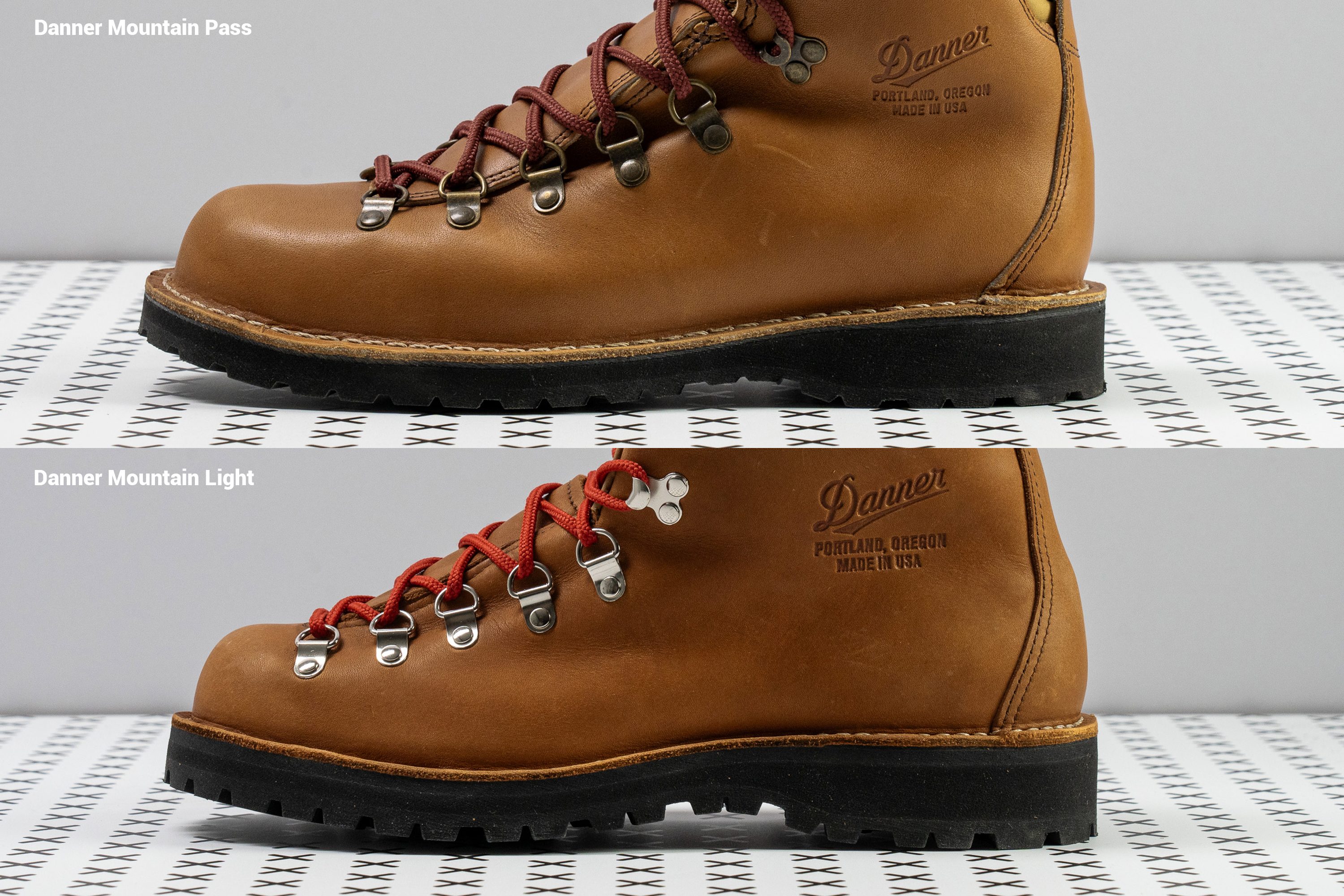
| Mountain Pass | 23.8 mm |
| Media | 23.0 mm |
Drop
En cuanto cortamos estas Danner por la mitad, vimos lo enorme que era su talón en comparación con el antepié. Al final, esta diferencia crea un drop muy pronunciado, de 17,5 mm.
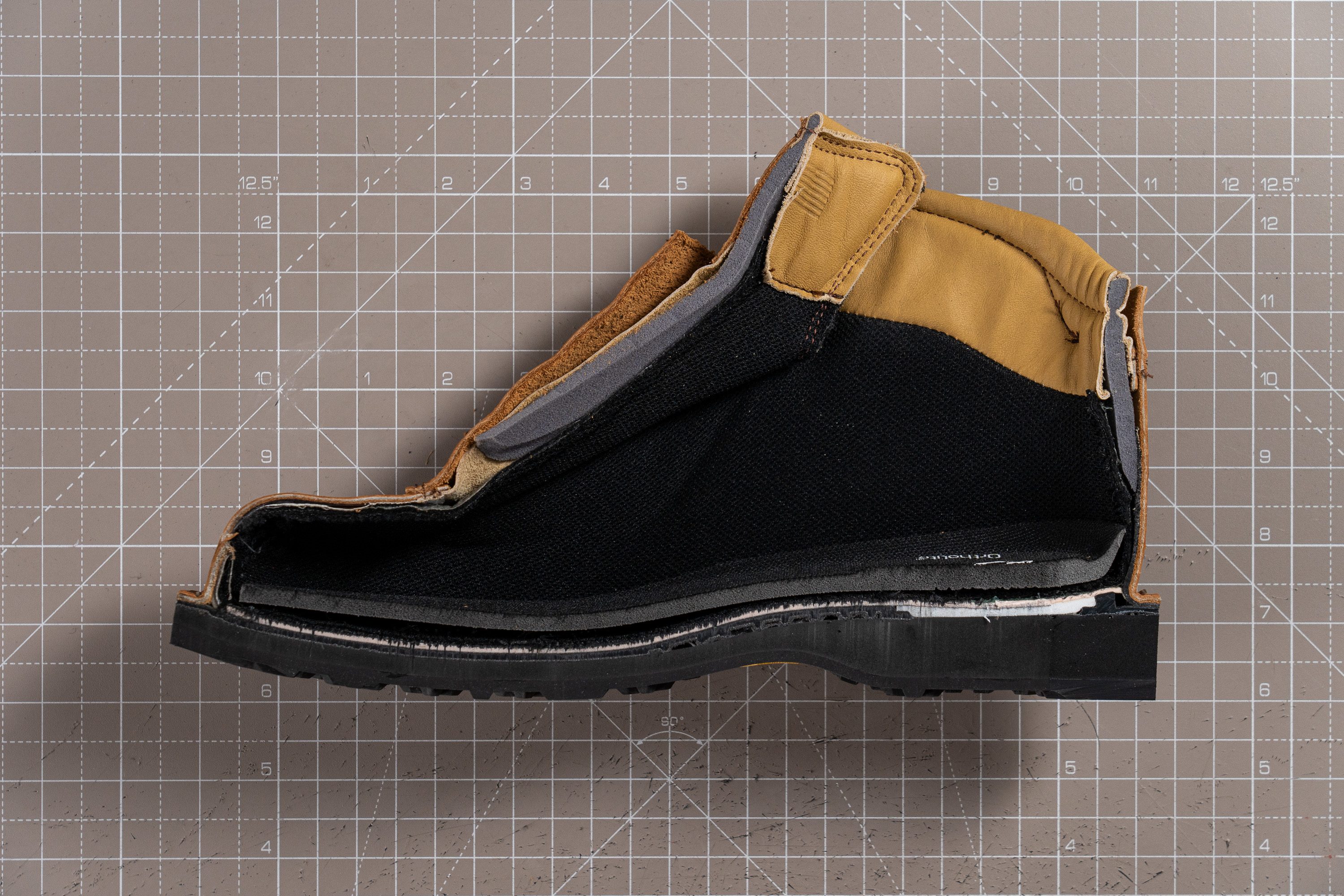
Son muy buenas noticias para la sujeción del tendón de Aquiles, ya que el talón tiene que estar más alto que los dedos para conseguir aliviar la tensión en este tendón. Pero claro, como el drop estándar ronda los 12-14 mm, 17,5 mm puede ser demasiado alto para algunas personas.
| Mountain Pass | 17.5 mm |
| Media | 13.3 mm |
Suavidad de la mediasuela
Es como si las botas de senderismo vintage y la amortiguación mullida existieran en universos paralelos.
Inspiradas en las antiguas botas de leñador, las Mountain Pass utilizan una espuma bastante firme para la mediasuela. Al presionar nuestro durómetro contra ella, marcó 34,6 HA, así que es un 25 % más dura que la media de las botas de senderismo.
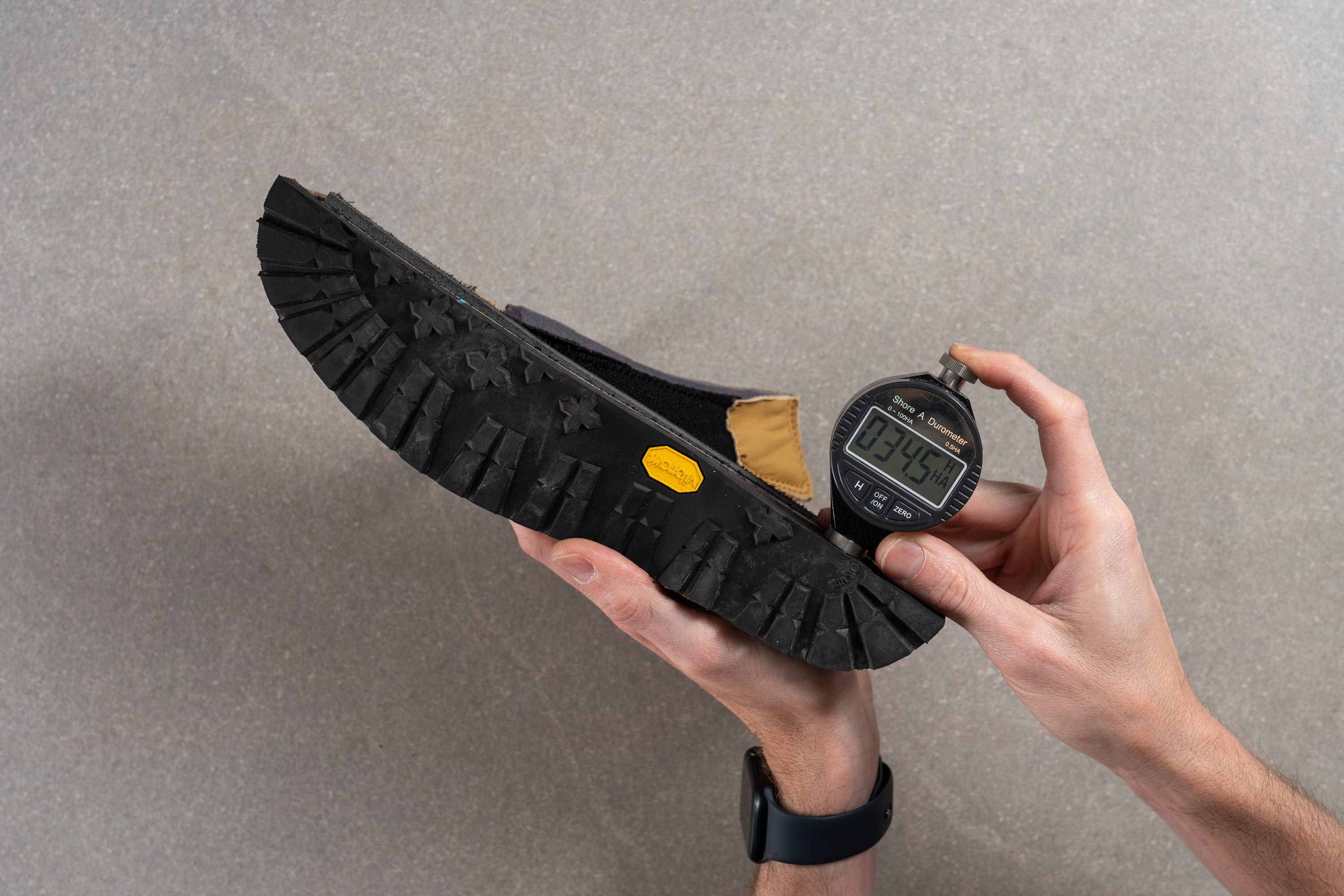
Es uno de los resultados más firmes que hemos visto en nuestro laboratorio, así que nos cuesta llamarla "amortiguación", la verdad. La pisada se siente muy firme, pero oye, esto también la hace estable.
| Mountain Pass | 34.6 HA |
| Media | 28.4 HA |
Tallaje y ajuste
Talla
Las Danner Mountain Pass tallan bien (14 votos).
Anchura / Ajuste
Aunque las Danner Mountain Pass están disponibles en tallas anchas, descubrimos que eran incluso más estrechas que la anchura D estándar de otras marcas.
Cuando medimos el punto más ancho de las botas, nuestro calibre marcó solo 91,3 mm, así que son un par de milímetros más estrechas que la media.

A ver, ¡al menos no son tan estrechas como las Mountain Light (89,9 mm)! Y es que ambos pares se fabricaron con hormas diferentes: la 650 (Mountain Light) y la 503 (Mountain Pass). Según la web de la marca, esta última tiene un "casual fit" o ajuste casual.
Además, como puedes ver en la foto de abajo, los cordones de las Pass no llegan hasta la zona de los dedos, como pasa en las Light.
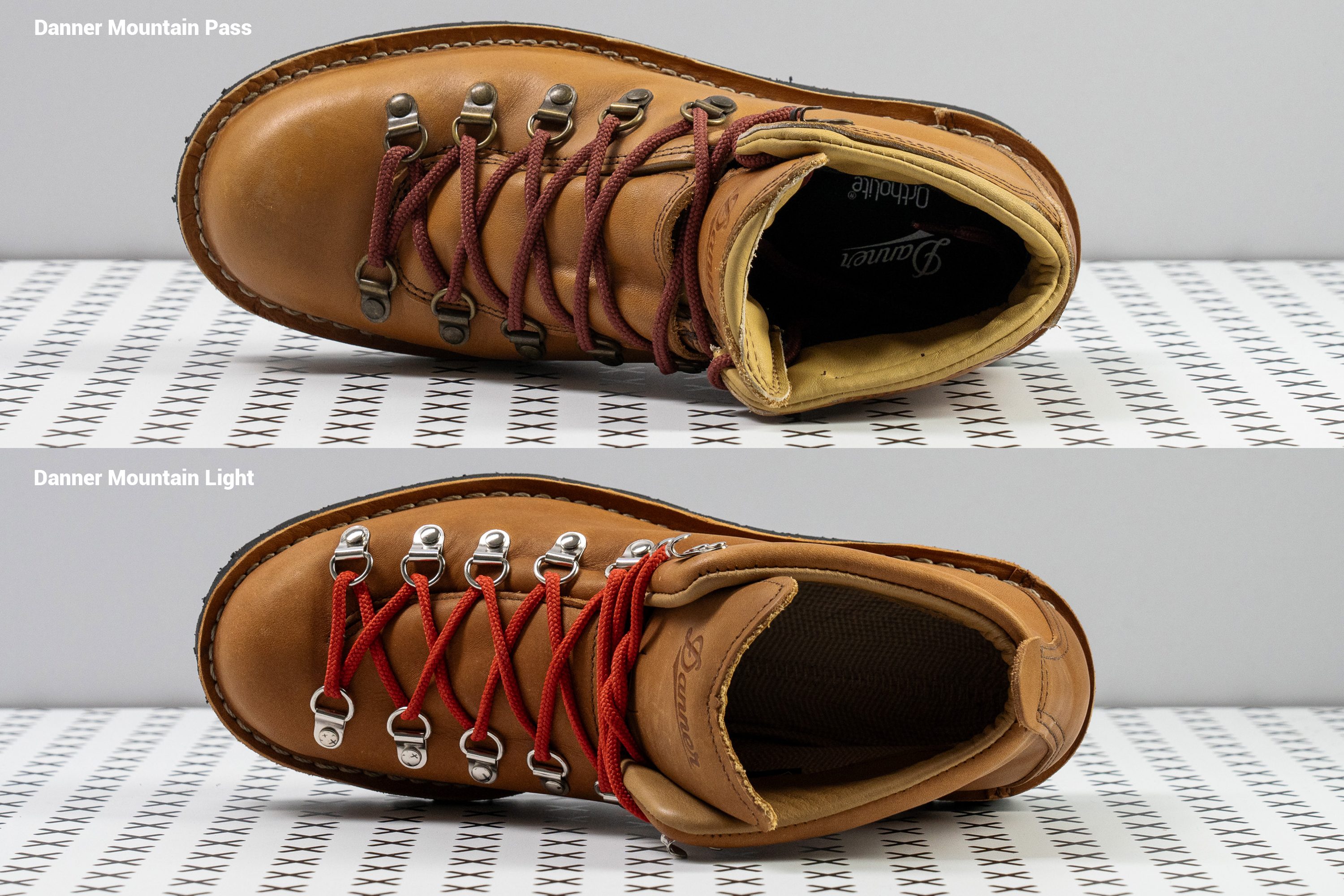
| Mountain Pass | 91.3 mm |
| Media | 93.8 mm |
Anchura de la parte delantera
Como era de esperar, la parte delantera de las Mountain Pass se estrecha incluso más hacia delante. Nuestro calibre volvió a marcar un resultado inferior a la media, de 67,6 mm, en la zona del dedo gordo.
Pero, afortunadamente, no son tan estrechitas como las Mountain Light, que solo llegan a los 64,5 mm
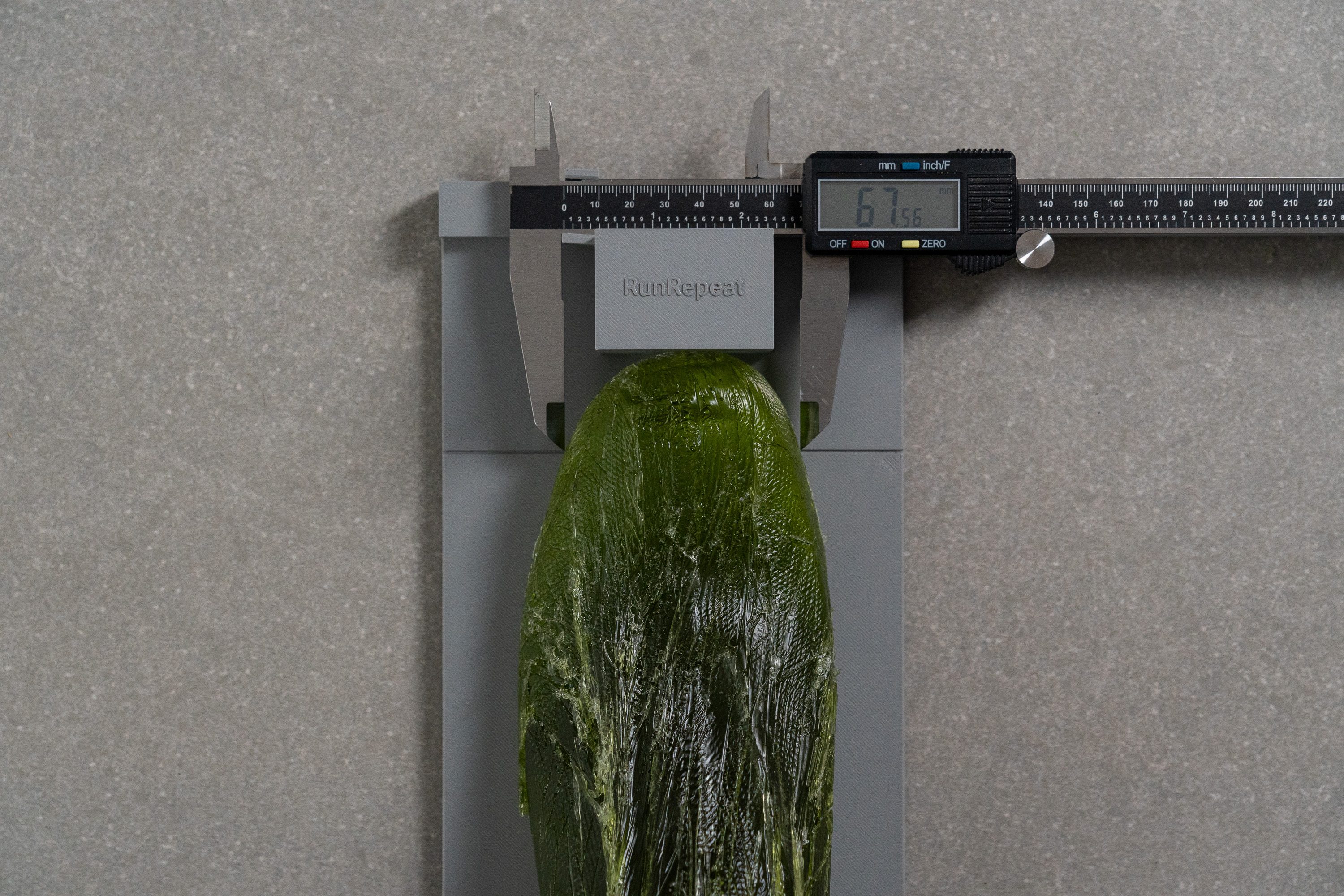
| Mountain Pass | 67.6 mm |
| Media | 71.2 mm |
Altura de la parte delantera
La altura de la parte delantera de estas botas tampoco es nada del otro mundo. Nuestro calibre marcó unos moderados 25,8 mm, así que no alcanza la media, pero tampoco aprieta demasiado los dedos.
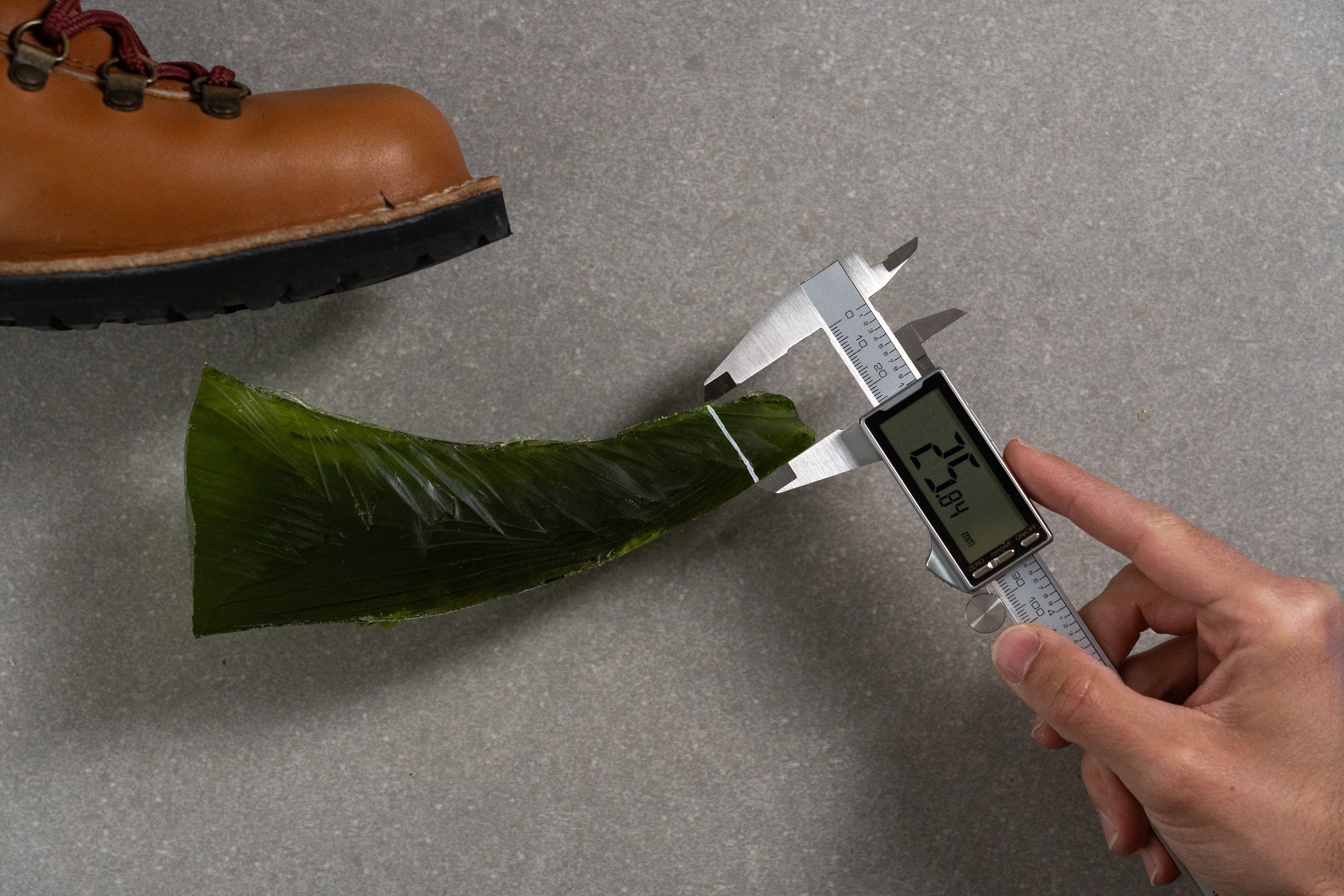
| Mountain Pass | 25.8 mm |
| Media | 27.4 mm |
Cordones
Estas botas tienen un cierre de cordones largo y heredado que nos parece útil tanto en cuanto a forma como en cuanto a función.
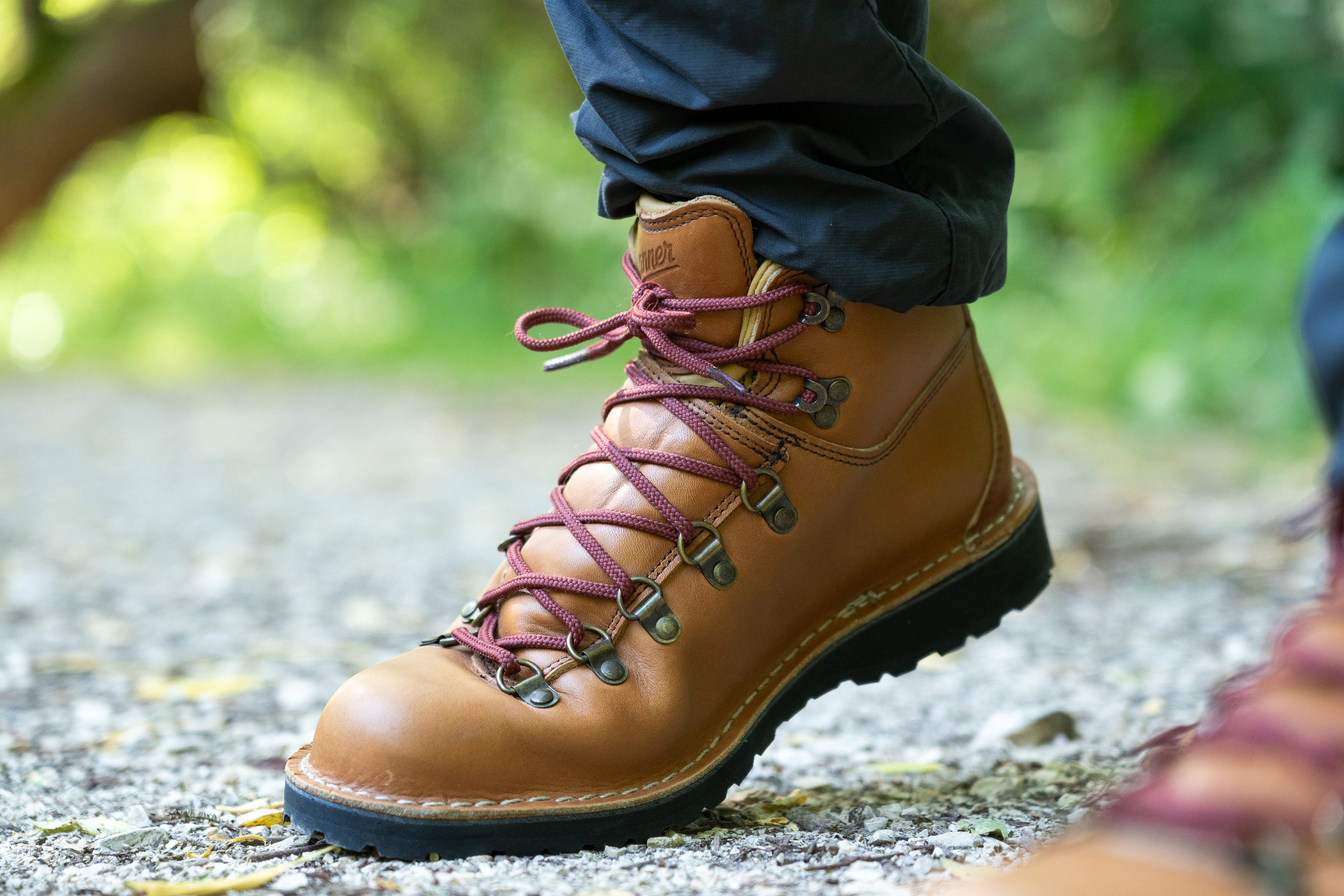
Desde un punto de vista práctico, este tipo de cordones ayuda a darle más estructura a las botas, haciendo que la presión de los cordones sea más uniforme en todo el empeine. Vamos, que no necesitas atarte muy fuerte los cordones para sentir sujeción.
Y en cuanto al estilo, ¿no te parece muy chulo?
Tracción / Agarre
Profundidad del dibujo de la suela
Según la web de la marca, las Mountain Pass se diseñaron "pensando en el senderismo ultraligero y las calles de la ciudad".
Así que, ya desde el minuto 1 nos pusieron el listón bastante bajo en lo que se refiere a sus tacos y agarre.
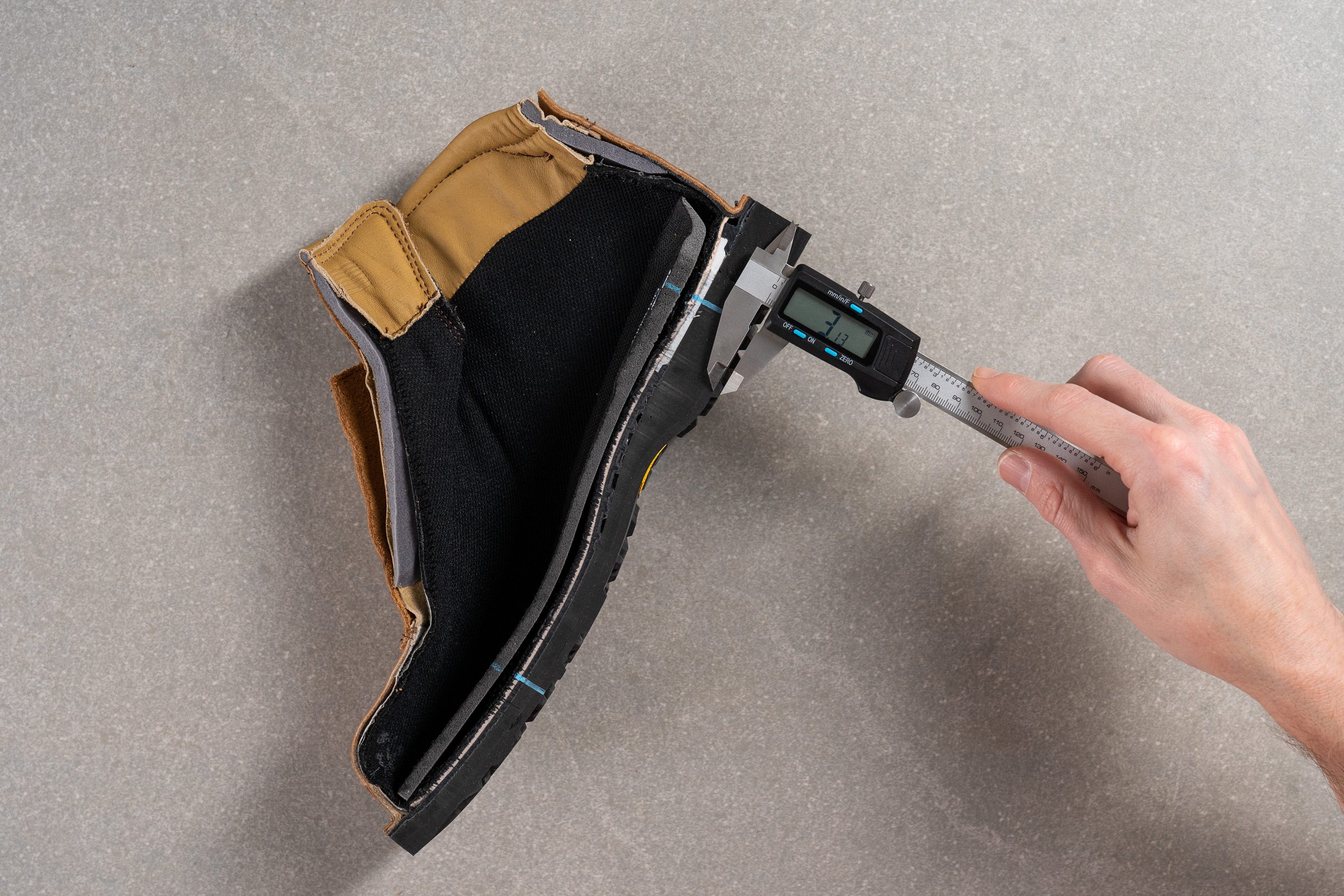
Al medir la profundidad de los tacos con un calibre, comprobamos que son menos profundos que la media. Sus 3,1 mm los hacen 1 mm más pequeños de lo que solemos ver, así que no son la mejor opción para zonas embarradas, rocosas o cualquier otro tipo de terreno difícil.
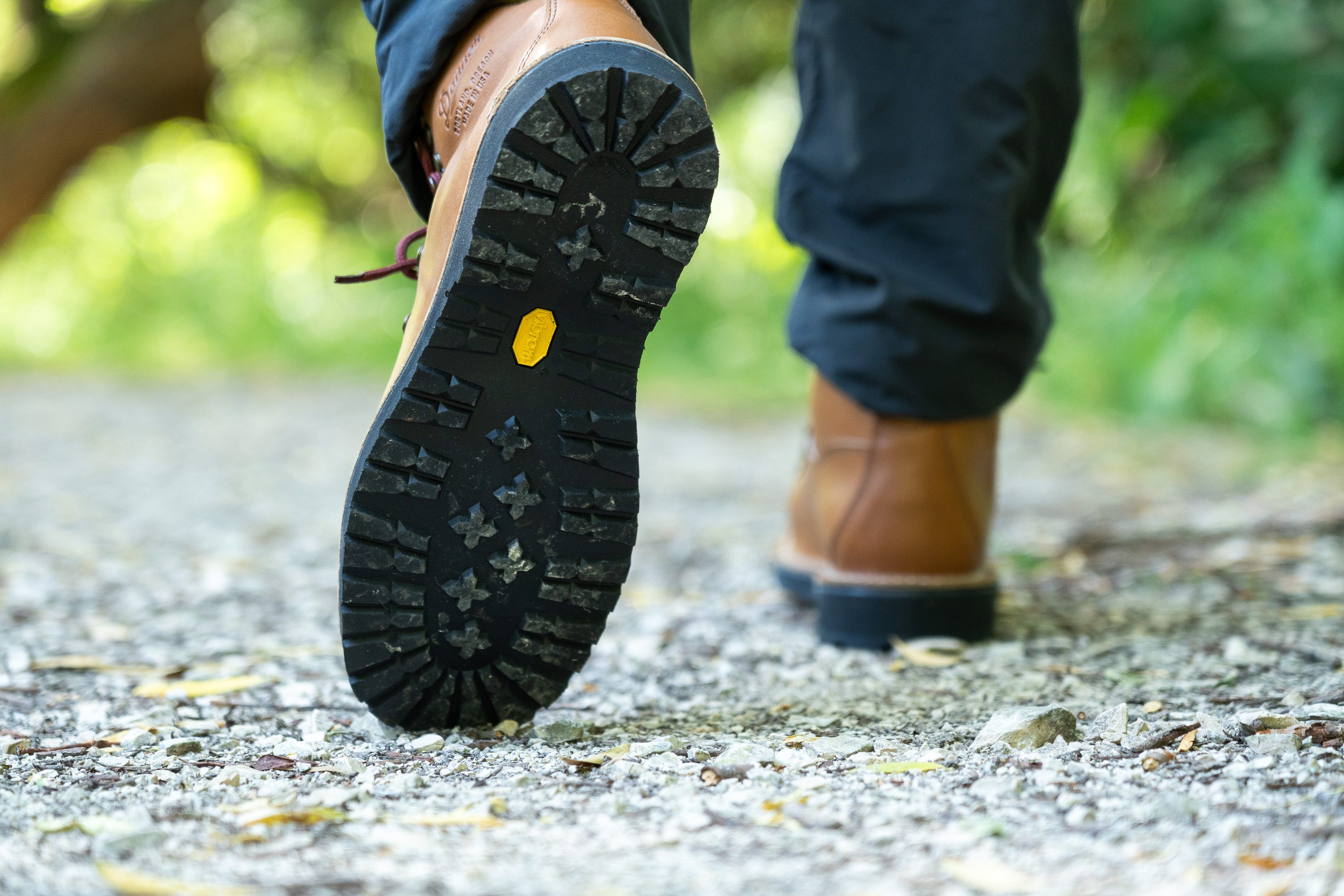
Estamos de acuerdo con la descripción que da Danner, y recomendamos limitar el uso de estas botas a los senderos más fáciles y a la ciudad.
| Mountain Pass | 3.1 mm |
| Media | 4.3 mm |
Flexibilidad / Rigidez
Flexibility / Stiffness
If you are used to buttery-soft heel-to-toe transitions in your footwear, the Danner Mountain Pass will give you a bit of a culture shock.
You wouldn't expect a leather boot with a shank to bend so easily, right?
But let the numbers talk now. Using a gauge, we measured how much force it takes to bend the boot to a 90-degree angle. At 57.7N, it took 30% more than the average hiking boot!
But even though it's on the stiffer side, the Mountain Pass is not as unforgiving as the Mountain Light (it took a massive 80.3N to bend that one!).
En esta prueba se utiliza una metodología antigua, así que no verás las zapatillas que hemos analizado últimamente en la tabla. Los resultados obtenidos con metodologías distintas no se pueden comparar.
| Mountain Pass | 57.7N |
| Media | 44.3N |
Rigidez en frío (%)
Lo bueno es que las Mountain Pass no se volverán incluso más rígidas con el frío.

Después de meterlas 20 minutos en el congelador, comprobamos que solo se volvían un 9,5 % más rígidas. Es mucho menos que la media, cuya rigidez suele aumentar en un 25 %.
Vamos, que no tienes que "poner a descongelar" a estas Danner antes de irte de ruta.
| Mountain Pass | 10% |
| Media | 24% |
Peso
Las Danner siguen batiendo récords de peso en nuestro laboratorio, y las Mountain Light son las ganadoras (y por bastante) con sus 802 g.
Por suerte, las Mountain Pass no pesan tantísimo, y aunque se parecen un montón a las Mountain Light, nuestra báscula "solo" marcó 672 g.
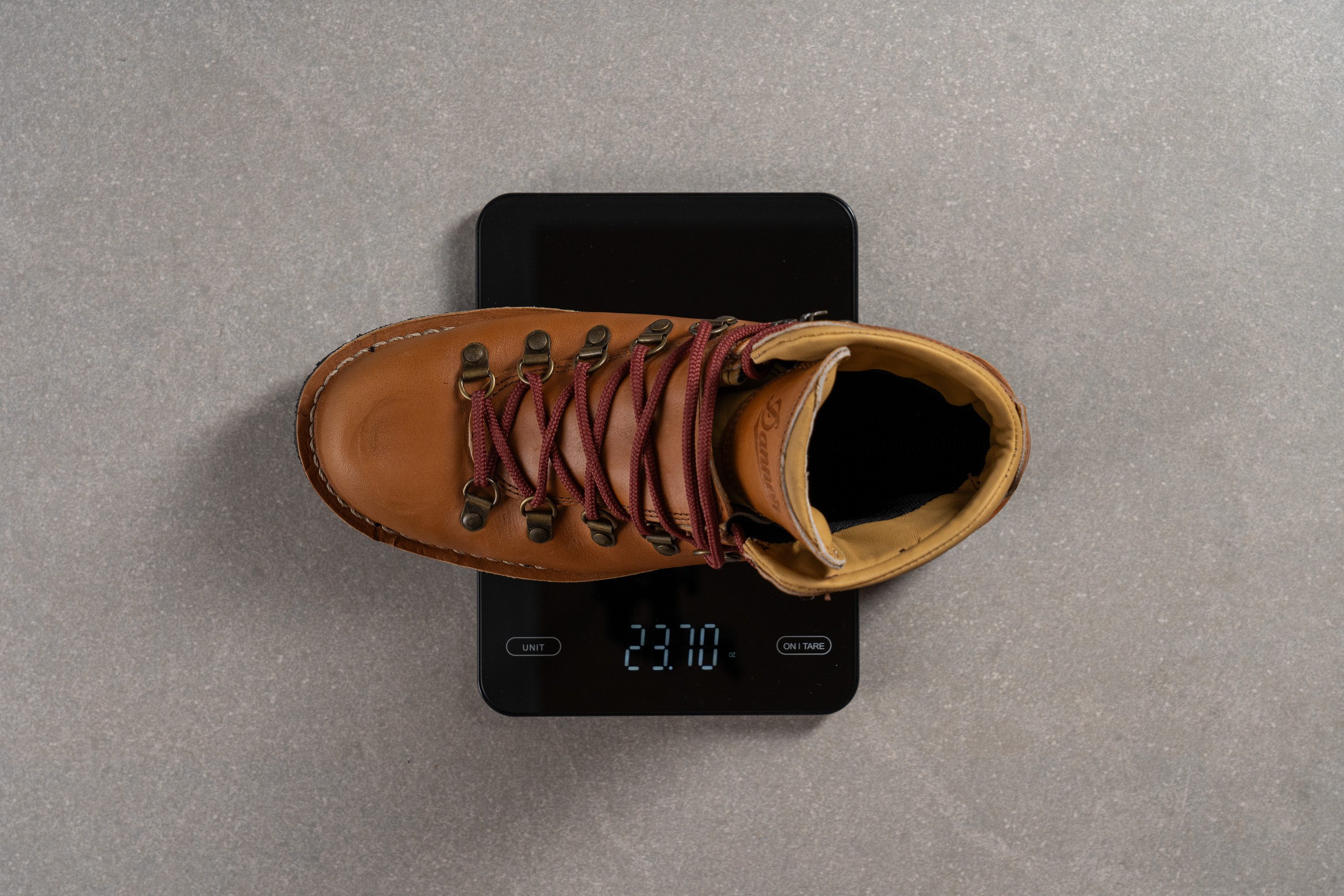
Con unas botas de senderismo como estas, lo mejor es que te vayas mentalizando de que tus pies van a tener que lidiar con ese peso extra. Al final del día te sentirás más cansado que con unas botas más ligeras.
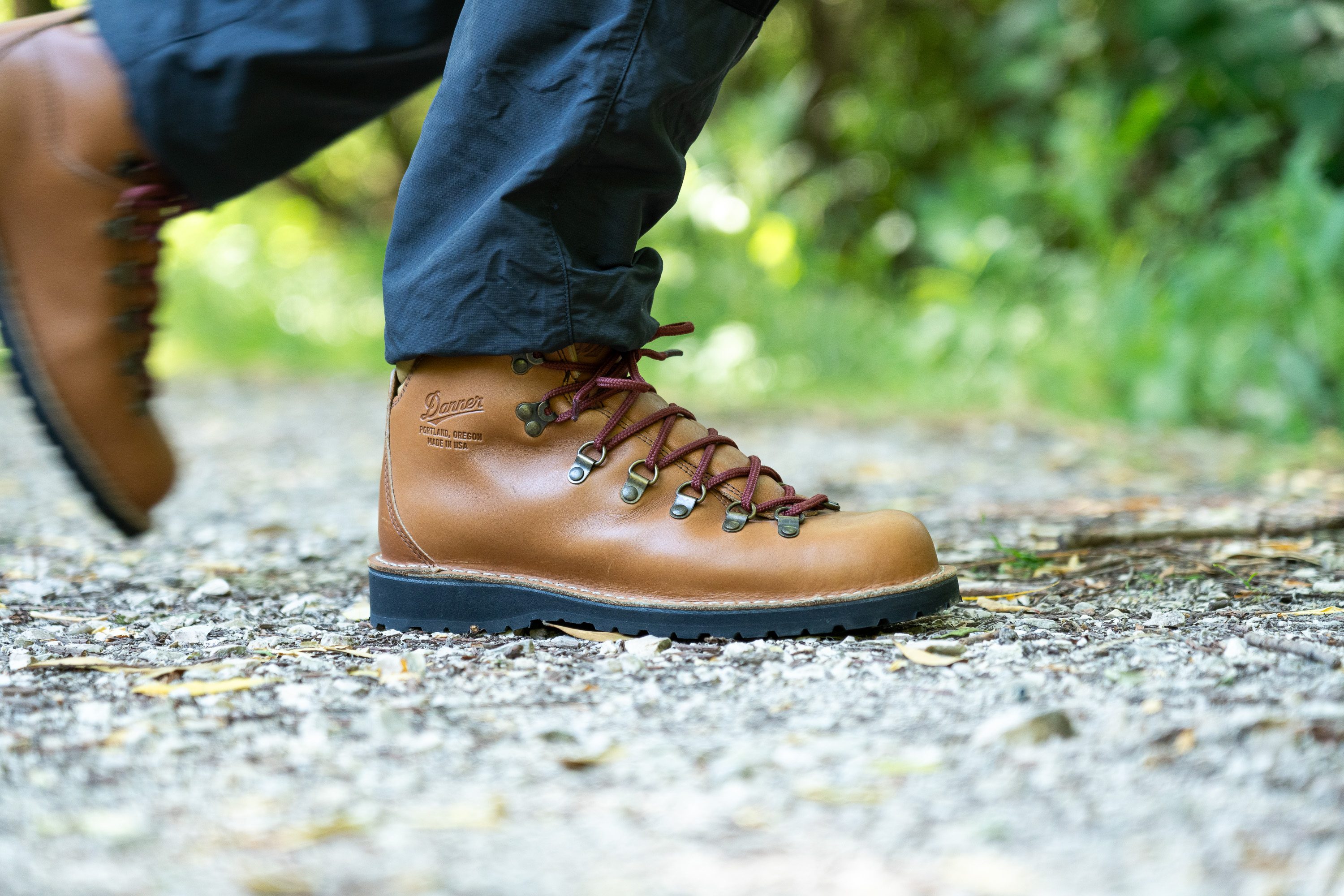
| Mountain Pass | 23.7 oz (672g) |
| Media | 18.7 oz (531g) |
Transpirabilidad
Con su cuello de casi 13 cm totalmente cubierto de cuero grueso, nunca jamás pensamos que las Mountain Pass fuesen a ser unas botas transpirables.
Como puedes ver en nuestra prueba de humo, el robusto upper de estas Danner no deja que salga nada de humo, y no hay ni un solo agujerito para que el aire entre y salga.
Lo bueno es que las Mountain Pass son unas botas ideales para todo el año. Sí, vale, no son la mejor opción para los extremos (un calor abrasador o un frío que pela), pero conseguirán que tus pies estén felices y contentos en un rango de temperaturas bastante amplio. Además, siempre puedes probar con calcetines de distintas densidades según el tiempo que haga.
| Mountain Pass | 1 |
| Media | 1.3 |
Resistencia al agua
En este análisis vamos a hablar del color Horween Rio. Es la versión de estas botas que no es impermeable, y tiene un forro Dri-Lex transpirable en el interior.
De todos modos, como son de cuero y de cuello alto, estas botas ofrecen un nivel básico de resistencia al agua, así que deberían mantenerte los pies secos cuando chispea o cuando te salpique un poco de agua. Pero si te pilla un chaparrón, si metes las botas en el río o si pisas un charco, lo más probable es que se te empapen los pies.
Para esto, así como para cuando hace un frío que pela o nieva, creemos que la versión Gore-Tex de este modelo es mejor. Los colores Gunmetal, Black Glace y Smores vienen todos con un forro impermeable de Gore-Tex y, curiosamente, cuestan exactamente lo mismo que sus compañeras con Dri-Lex, que no es impermeable.
Estabilidad
Prueba de estabilidad lateral
Con las Danner Mountain Pass, te puedes ir olvidando de que se te tuerza un tobillo.
Desde la base, estas botas tienen una estructura robusta que no deja que te bailen los tobillos ni en las superficies accidentadas.
Rigidez torsional
Nos fue imposible retorcer las Mountain Pass con nuestras propias manos, así que les dimos un 5/5 en nuestra prueba de rigidez torsional.
Parece que todos sus componentes están pensados para hacer que duren: la dura suela exterior de caucho, la mediasuela firme, el rígido cambrillón interno, la resistente parte superior de cuero, etc.
No tenemos más que cosas buenas que decir sobre la contención del pie y la estabilidad lateral de estas botas.
| Mountain Pass | 5 |
| Media | 4.4 |
Rigidez del contrafuerte del talón
Al comprobar manualmente la rigidez del contrafuerte del talón de estas botas, vimos que equilibran bien flexibilidad y rigidez, así que en nuestra escala del 1 al 5, les hemos dado un 3.
Teniendo en cuenta que su contrafuerte del talón es más rígido en la parte de abajo, volviéndose más flexible en la de arriba, no tuvimos ningún problema de deslizamiento del talón con las Mountain Pass.
Pero, la verdad, estamos muy contentos con ese poquito más de libertad de movimiento en el cuello de las botas.
| Mountain Pass | 3 |
| Media | 3.6 |
Anchura de la mediasuela - antepié
Las Danner Mountain Pass nos ofrecieron una pisada sólida durante nuestras pruebas de uso.
Además de su tener una estructura robusta y un cabrillón que les proporciona estabilidad, estas botas cuentan con una zona de aterrizaje bastante amplia, sobre todo en el antepié.

Al medir la parte más ancha de la suela, nuestro calibre marcó 115,6 mm, así que es 4 mm más ancha que la media. Nos sentimos muy estables con este par.
| Mountain Pass | 115.6 mm |
| Media | 111.5 mm |
Anchura de la mediasuela - talón
Aunque la anchura del talón de estas botas no alcanza la media del sector, nos pareció lo suficientemente ancho con sus 83,8 mm.
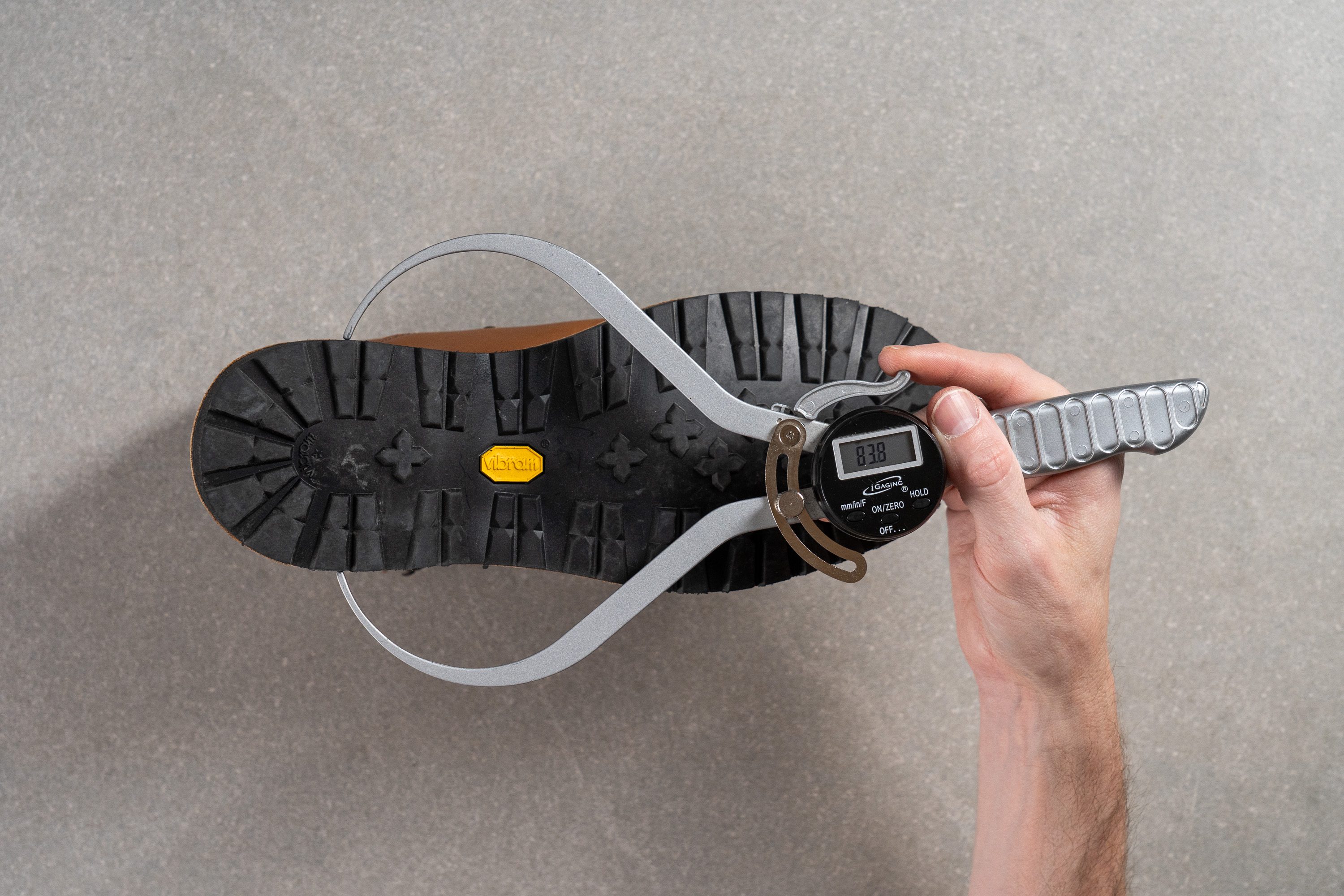
| Mountain Pass | 83.8 mm |
| Media | 87.6 mm |
Durabilidad
Durabilidad de la parte delantera
Las botas de Danner tienen una reputación muy buena en cuanto a durabilidad. Fabricadas en Portland, Oregón (EE. UU.), prometen la máxima calidad artesanal.
En cuanto sacamos las Mountain Pass de su caja, pudimos oler esa calidad. Sí, sí, ¡justo ese olor a cuero premium que te imaginas!
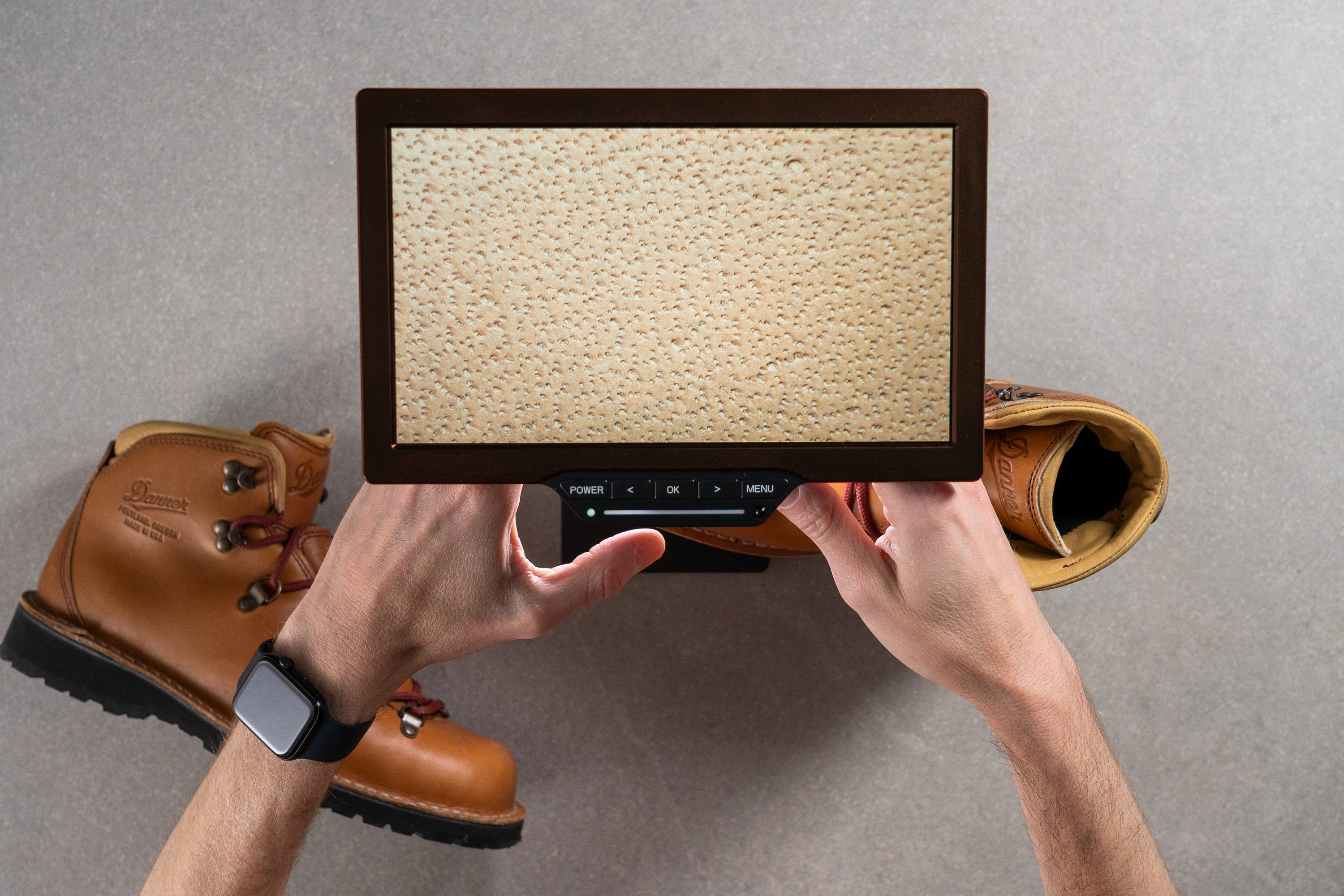
Cuando analizamos el material utilizando nuestro microscopio, vimos los puntitos típicos del cuero de grano gordo. ¡Qué maravilla!
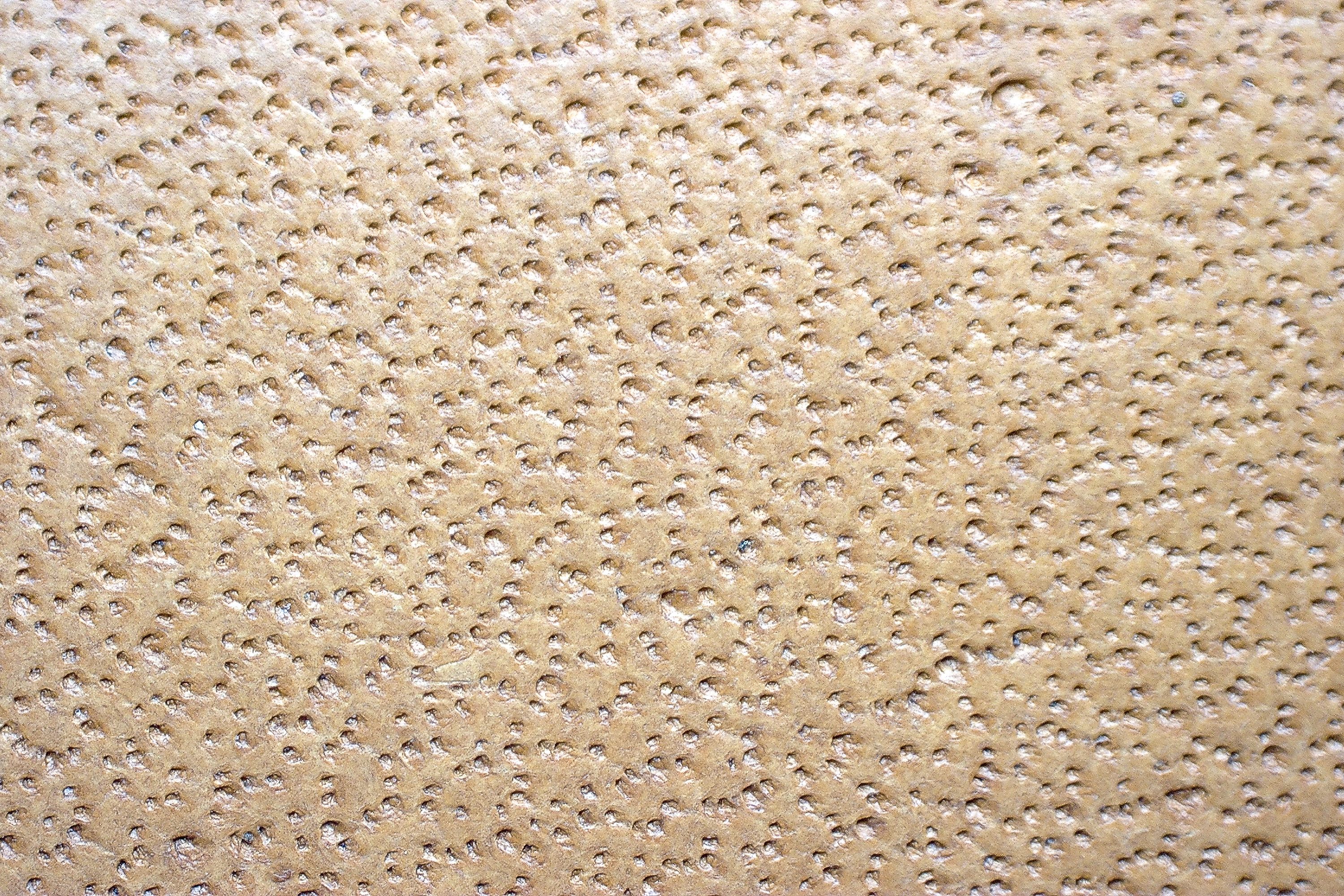
Vamos a ver si la resistencia al desgaste y la durabilidad de ese cuero están a la altura de su elevado precio.
Después de 12 segundos dándole caña a la parte delantera, solo vimos un pequeño rasguño, así que no nos quedó ninguna duda de que estas botas están hechas para durar. Se han llevado un 5/5 perfecto en durabilidad.
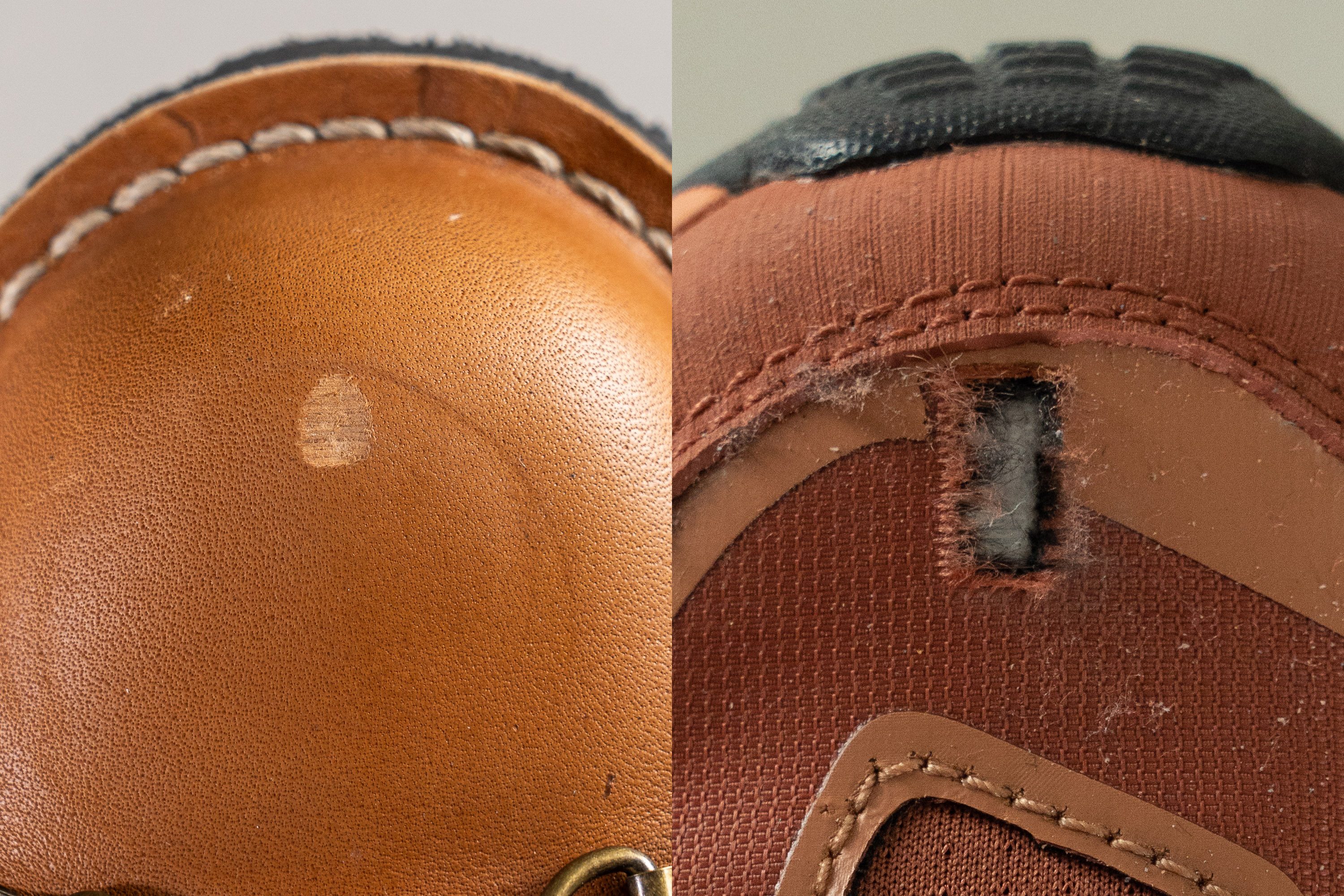
En comparación con las botas de senderismo que tienen parte superior sintética/textil, este modelo de cuero está fabricado para durar años y años.
| Mountain Pass | 5 |
| Media | 4.3 |
Durabilidad del acolchado del talón
La parte interior del cuello de las botas también está forrada de cuero, pero es más suave.
Nuestro Dremel no le hizo prácticamente nada, y mientras que los forros de malla terminan destrozados después de solo 4 segundos, las Mountain Pass se quedaron tal cual.
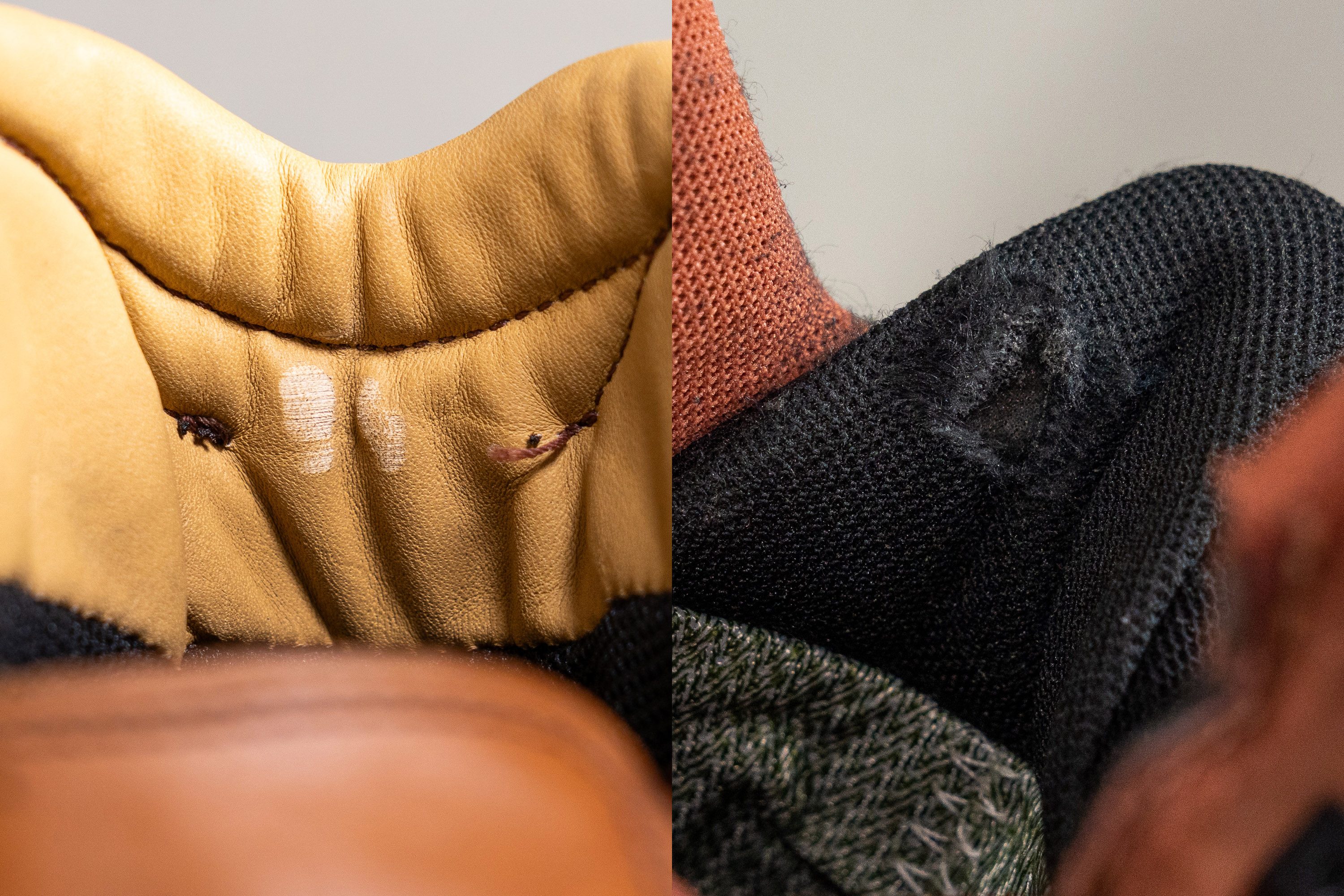
| Mountain Pass | 5 |
| Media | 3.6 |
Dureza de la suela
Cuando nos fijamos en la suela exterior de las Mountain Pass, nos dimos cuenta de que utiliza caucho Vibram, que es conocido por su calidad.
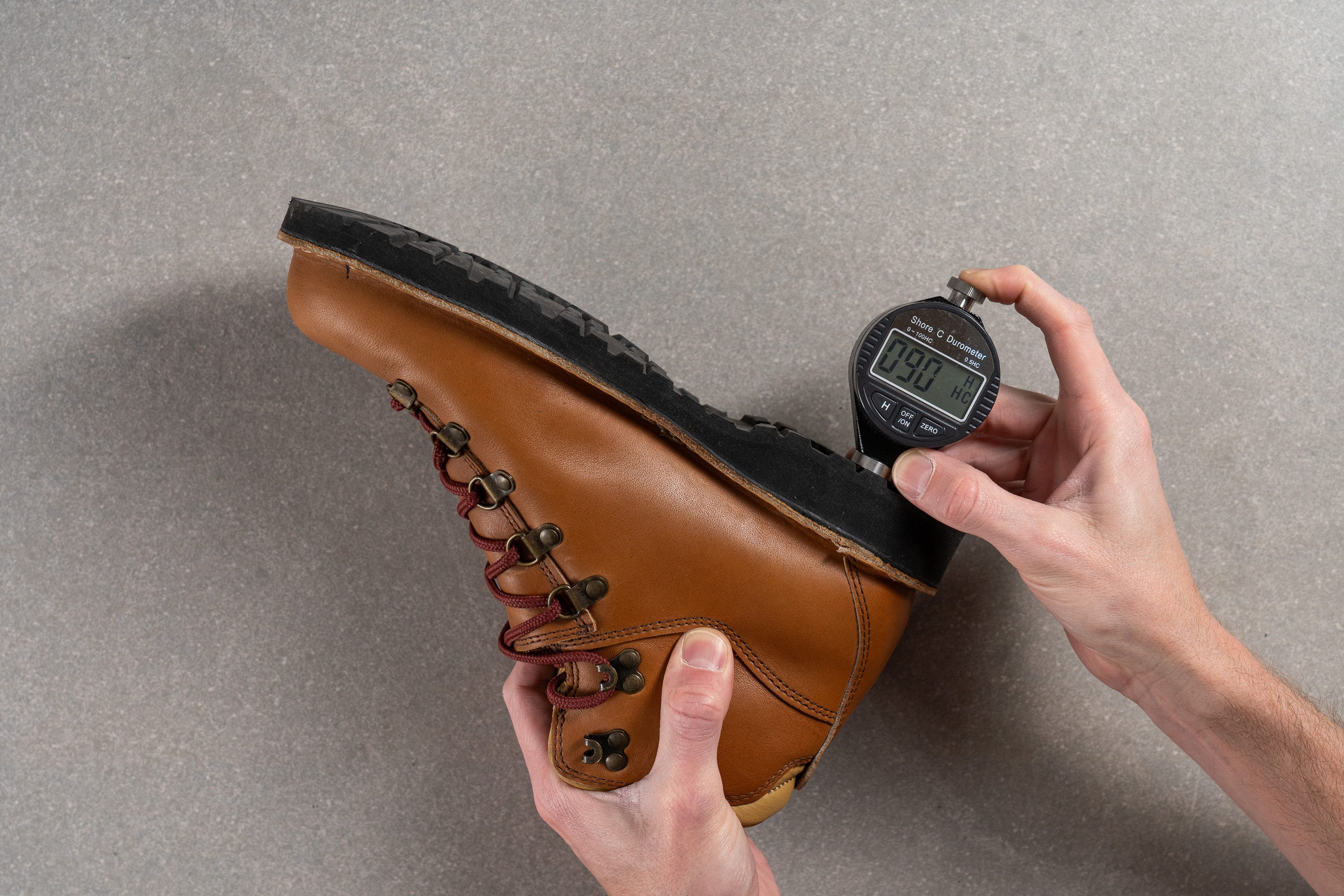
Como era de esperar, obtuvo un resultado duro en nuestro durómetro: 90 HC. Es una cifra estándar entre las botas de senderismo, lo que es una buena señal en cuanto a durabilidad.
| Mountain Pass | 89.9 HC |
| Media | 87.1 HC |
Durabilidad de la suela
Para comprobar su resistencia a la abrasión, volvimos a coger nuestro Dremel. Aumentando la velocidad a 10K RPM, retamos a las Mountain Pass a un duelo.
Nos quedamos bastante sorprendidos cuando vimos que la suela exterior de estas botas sufría muy pocos daños en comparación con la media. Nuestro medidor de desgaste de neumáticos marcó solo 0,5 mm, así que es uno de los compuestos más resistentes que hemos analizado.
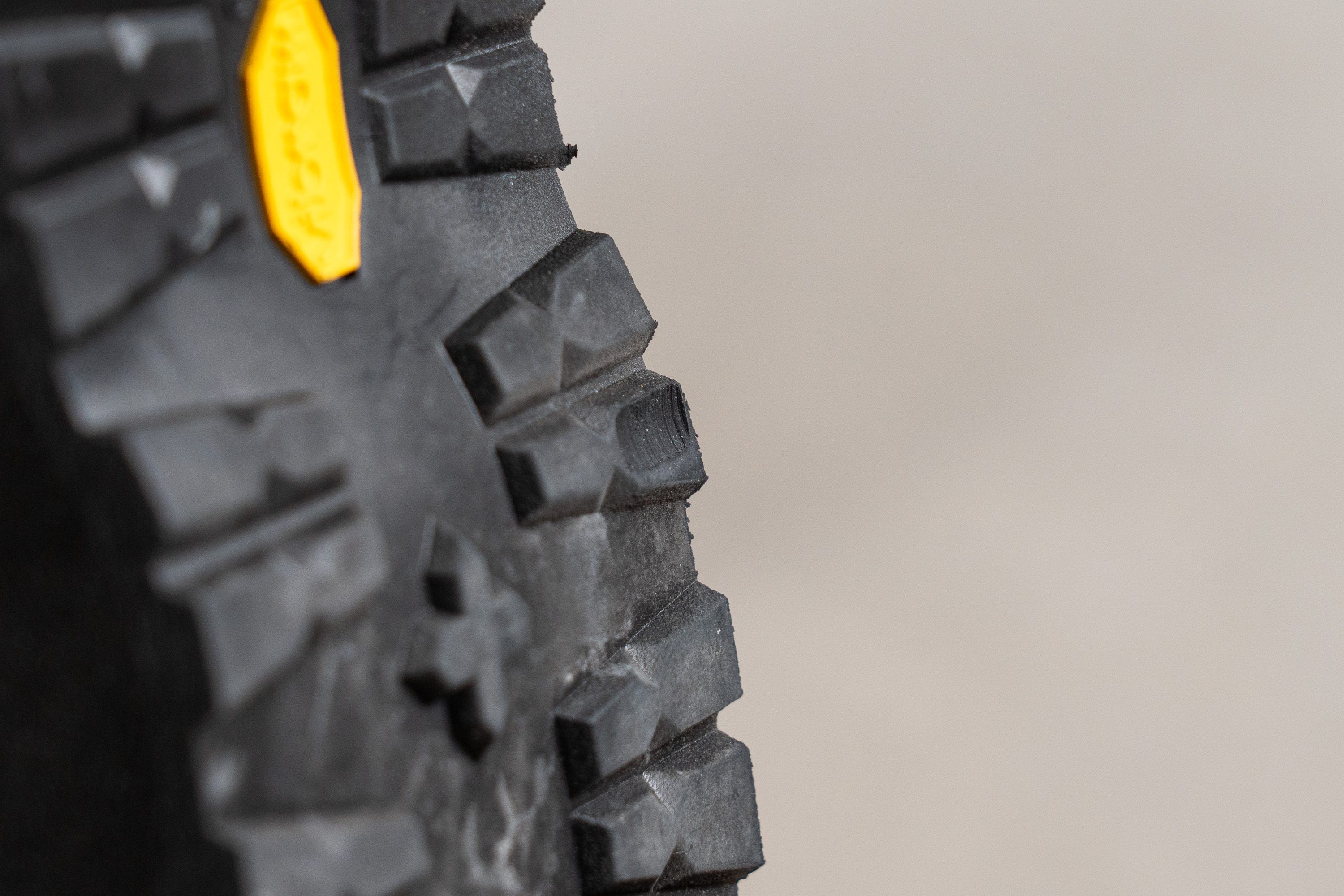
| Mountain Pass | 0.5 mm |
| Media | 0.8 mm |
Grosor de la suela
La cantidad de caucho utilizada en estas Danner también nos dejó respirar tranquilos.
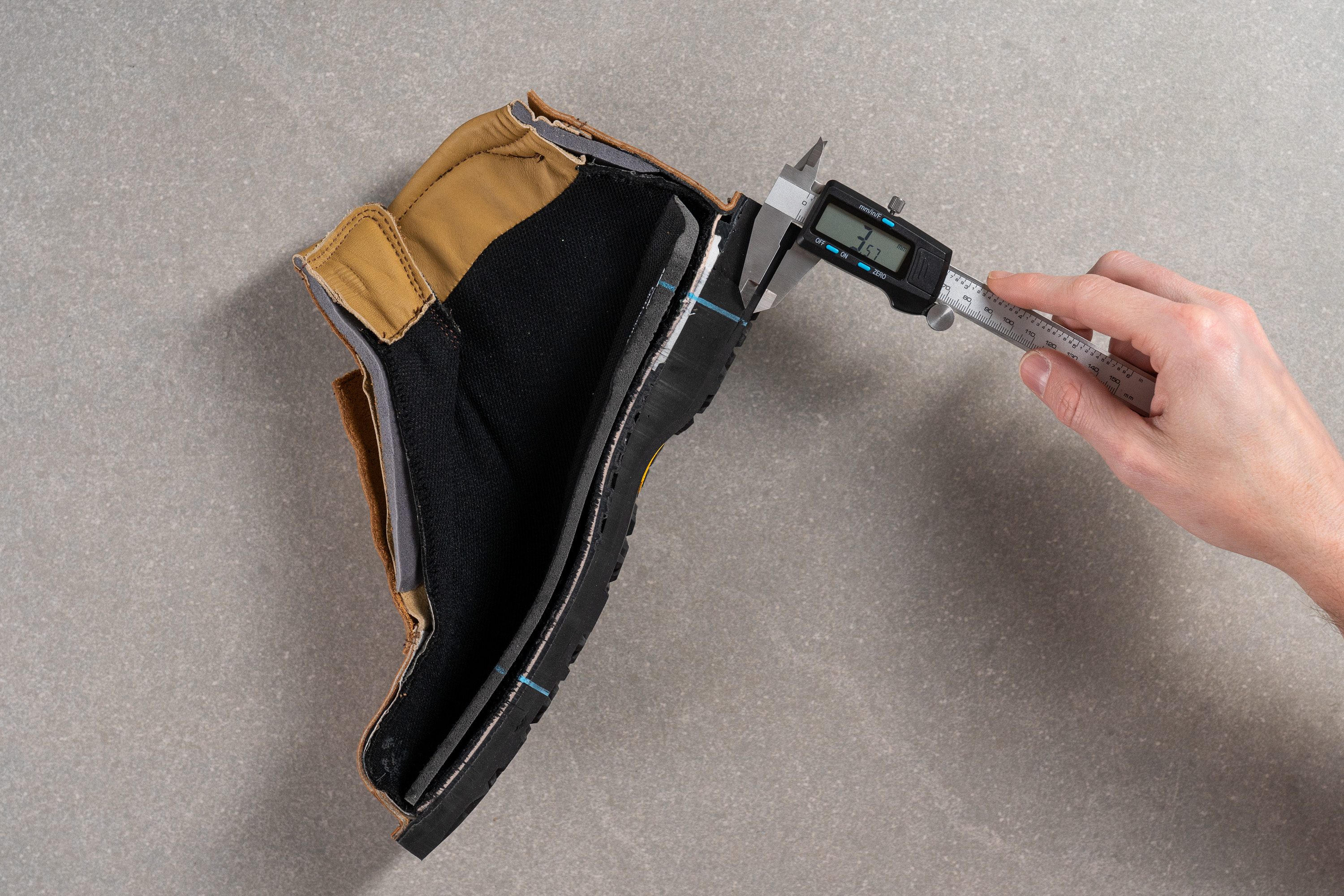
Con sus 3,6 mm (sin contar los tacos), ¡la suela exterior es hasta un poco más gruesa que la media! Vamos, que hay un buen motivo por el que la gente sigue llevando sus Danner favoritas durante años y años.
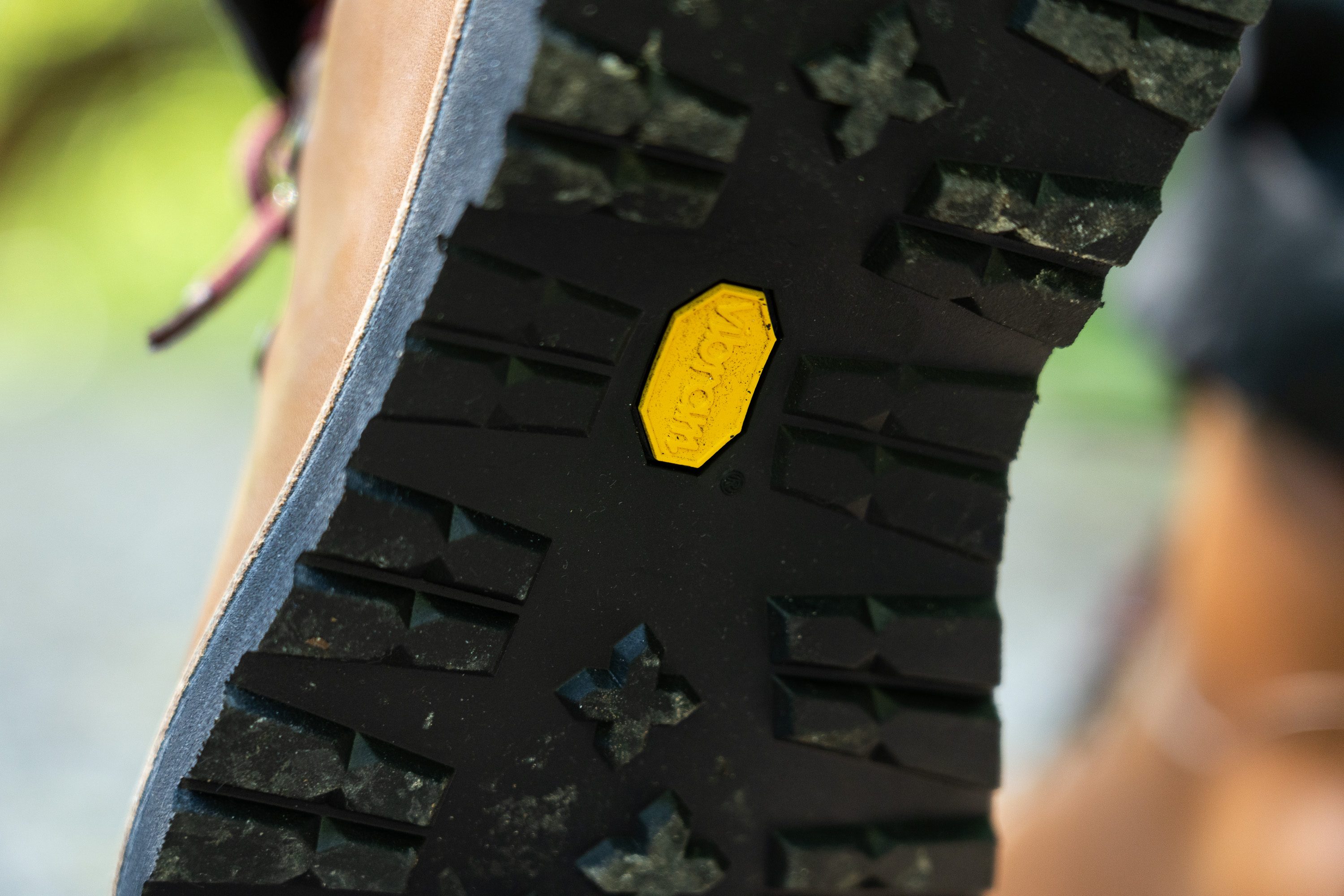
Y cuando el caucho se rompa del todo, puedes ponerles una suela nueva, ya que está cosida. Esto lo puedes hacer o mediante Danner, o con la ayuda del zapatero de tu ciudad.
| Mountain Pass | 3.6 mm |
| Media | 2.9 mm |
Varios
Grosor de la plantilla
Afortunadamente, pudimos disfrutar de las ventajas de la robusta suela de estas botas sin que nos hiciese daño. Nuestros pies estaban protegidos gracias a la plantilla tan bien acolchada que tienen, de 6,9 mm de grosor.
Está un poco más acolchada que la plantilla media y es de OrthoLite. Viene con una almohadilla extra debajo del talón para maximizar la protección contra impactos.
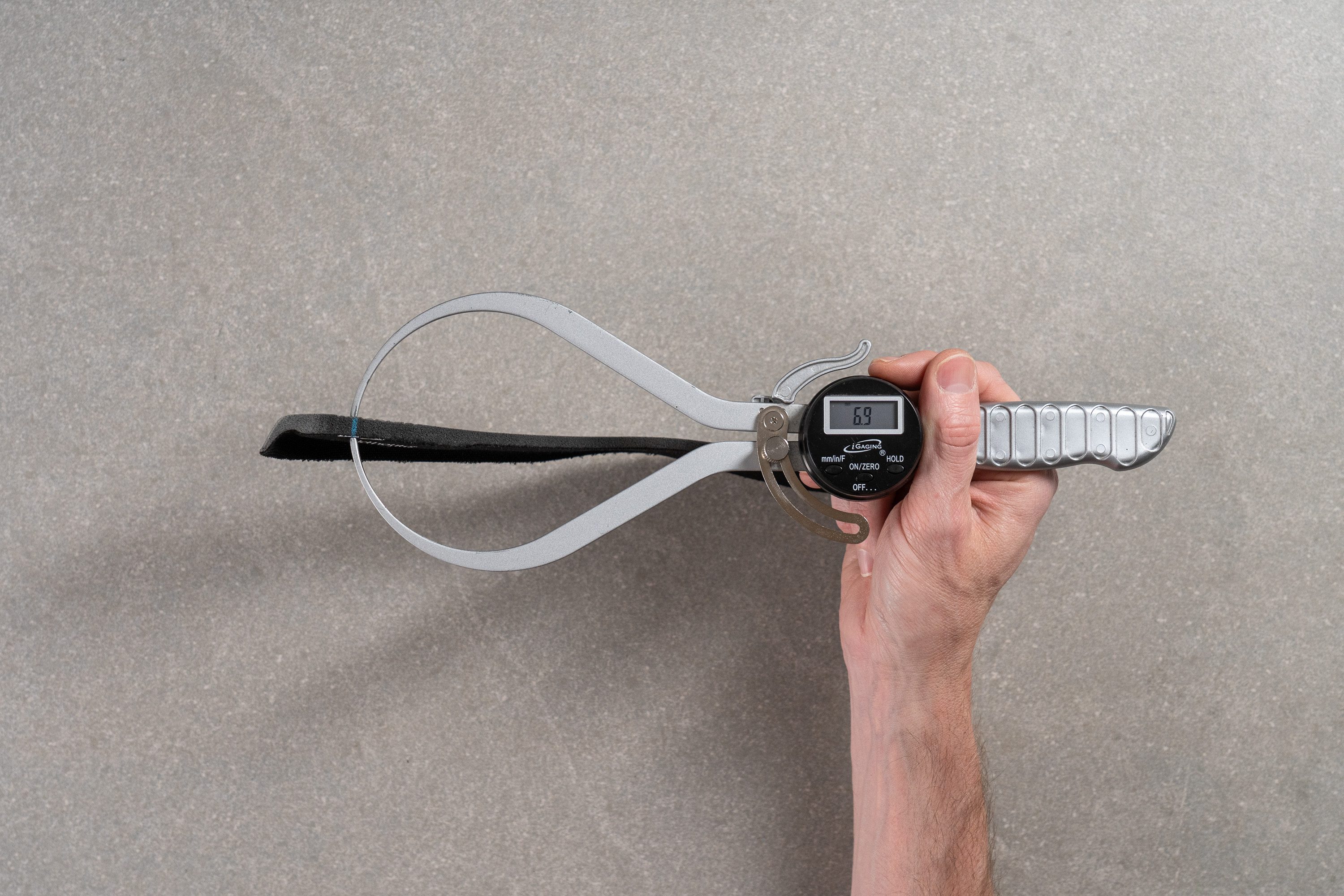
| Mountain Pass | 6.9 mm |
| Media | 6.0 mm |
Plantilla extraíble
La plantilla OrthoLite de las Mountain Pass es extraíble, así que la puedes cambiar fácilmente por otra si quieres o si lo necesitas.
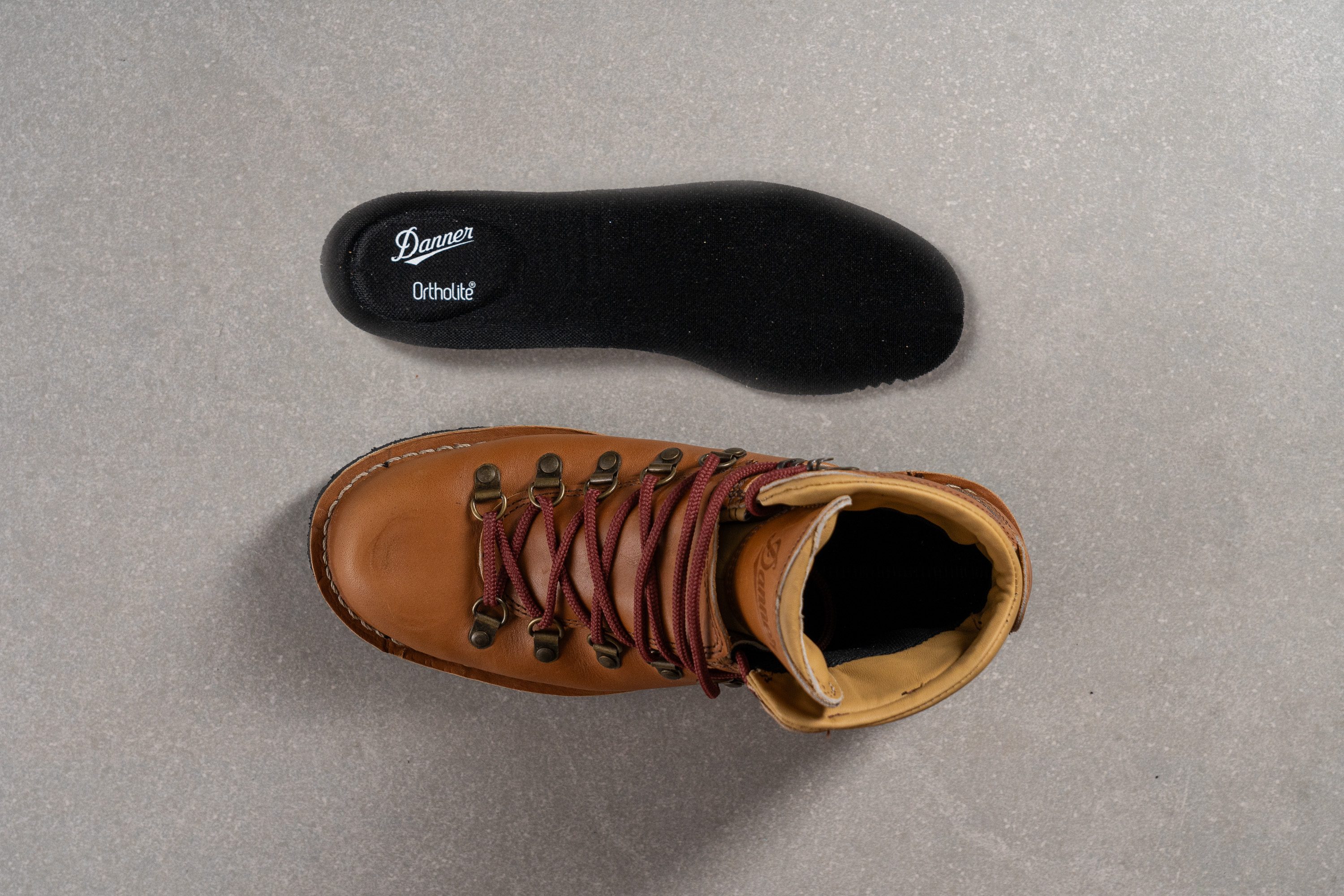
| Mountain Pass | Sí |
Suavidad de la mediasuela en frío
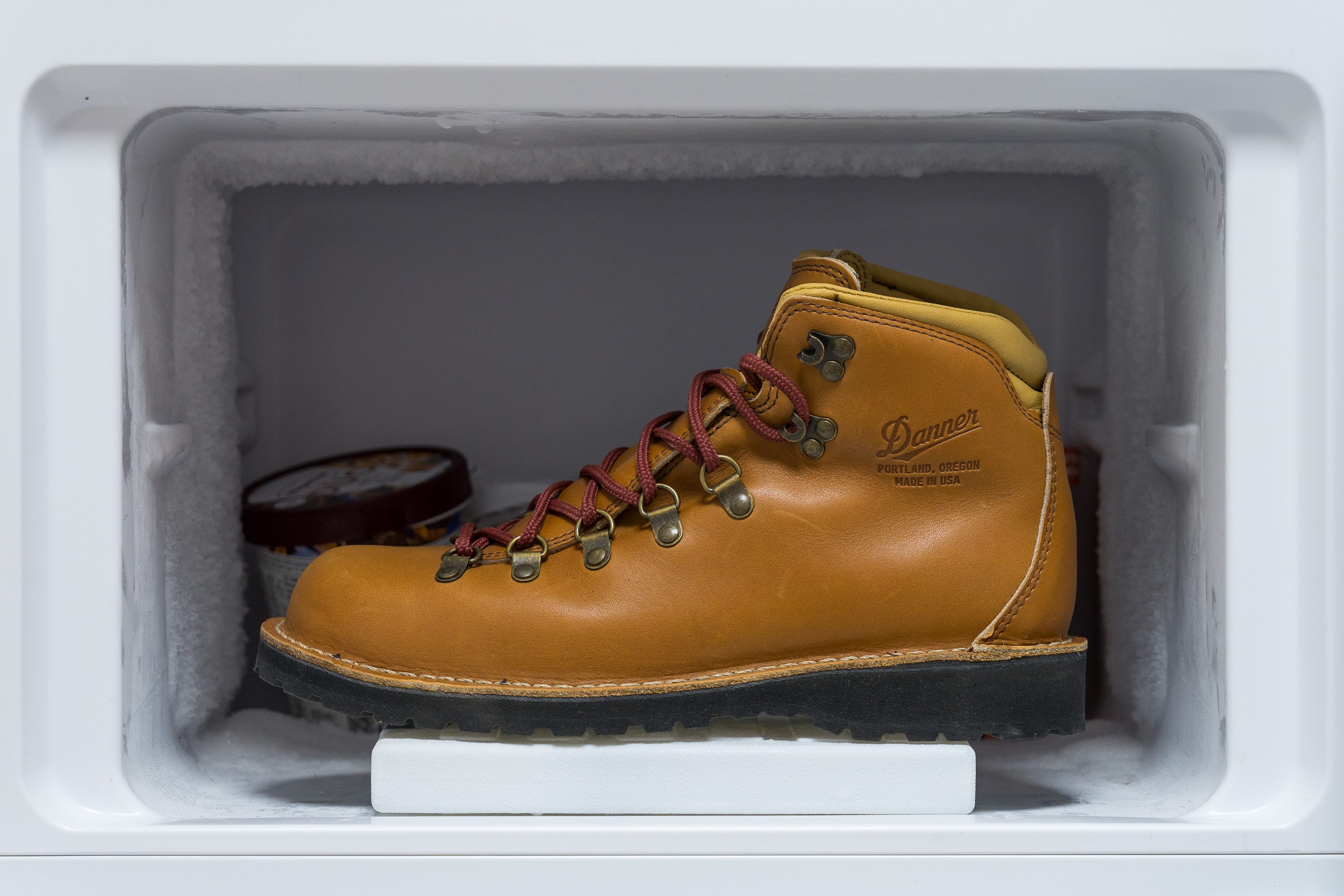
Rigidez de la mediasuela en frío (%)
No nos sorprendió descubrir que la espuma de la mediasuela de estas botas no se volvía mucho más firme con el frío.
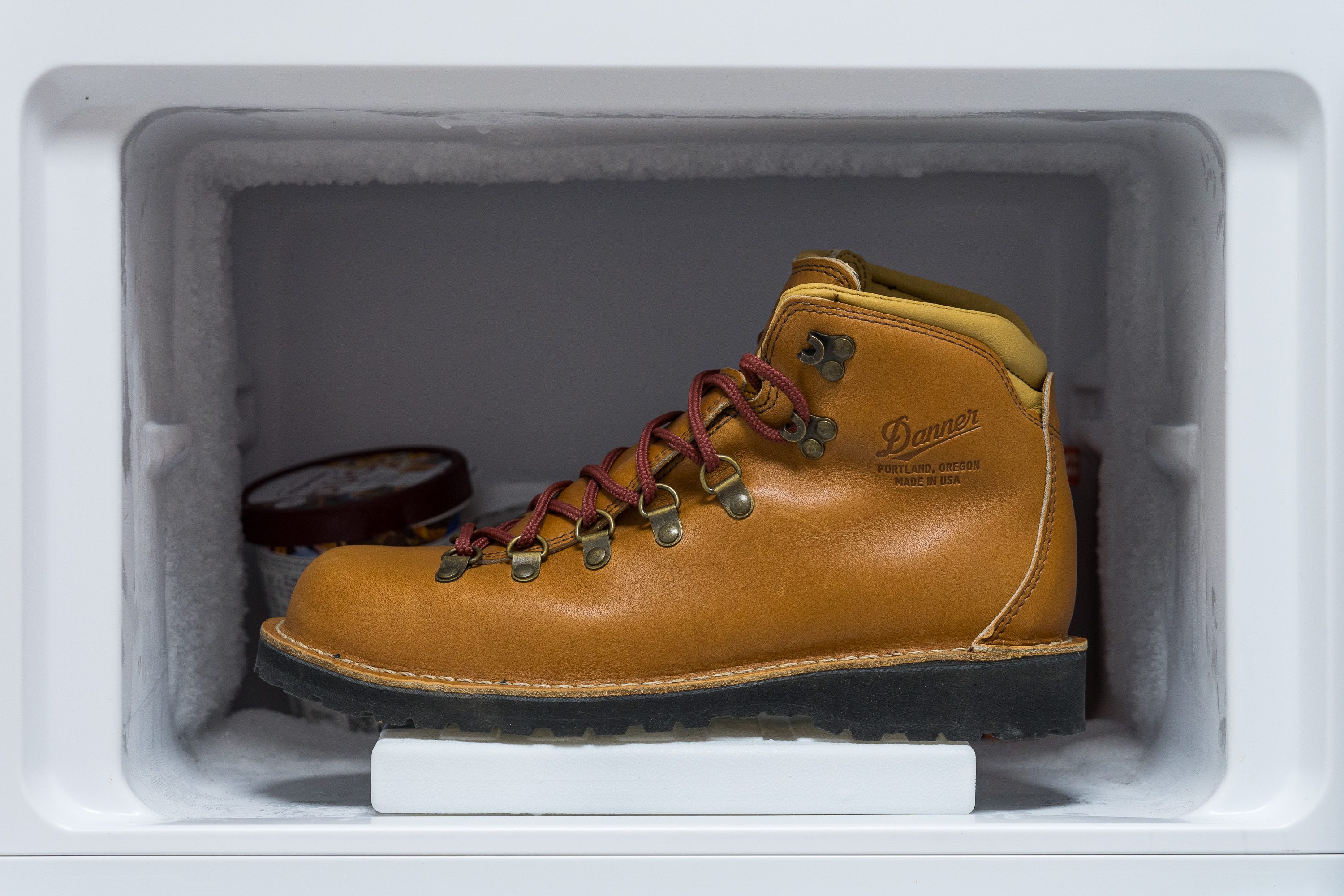
Después de meter las Mountain Pass 20 minutos en el congelador, el resultado solo aumentó en un 9 %.
| Mountain Pass | 9% |
| Media | 20% |
Elementos reflectantes
La verdad es que no nos esperábamos que unas botas vintage brillaran por la noche.
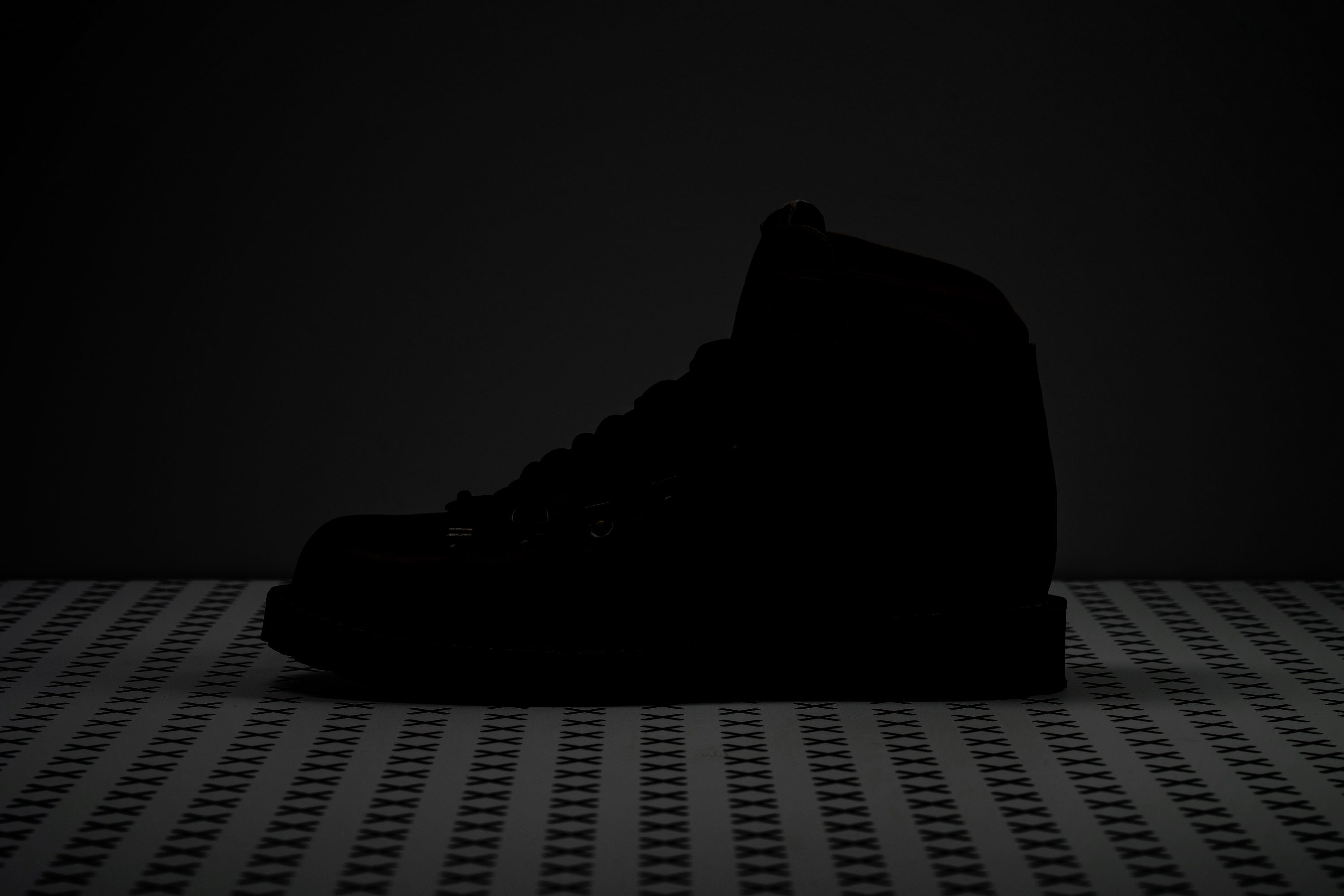
| Mountain Pass | No |
Acolchado de la lengüeta
La lengüeta bien acolchada ayuda mucho a aumentar la comodidad. Nuestro calibre marcó 10,9 mm cuando medimos su grosor, así que está la altura de la media de las botas de senderismo.
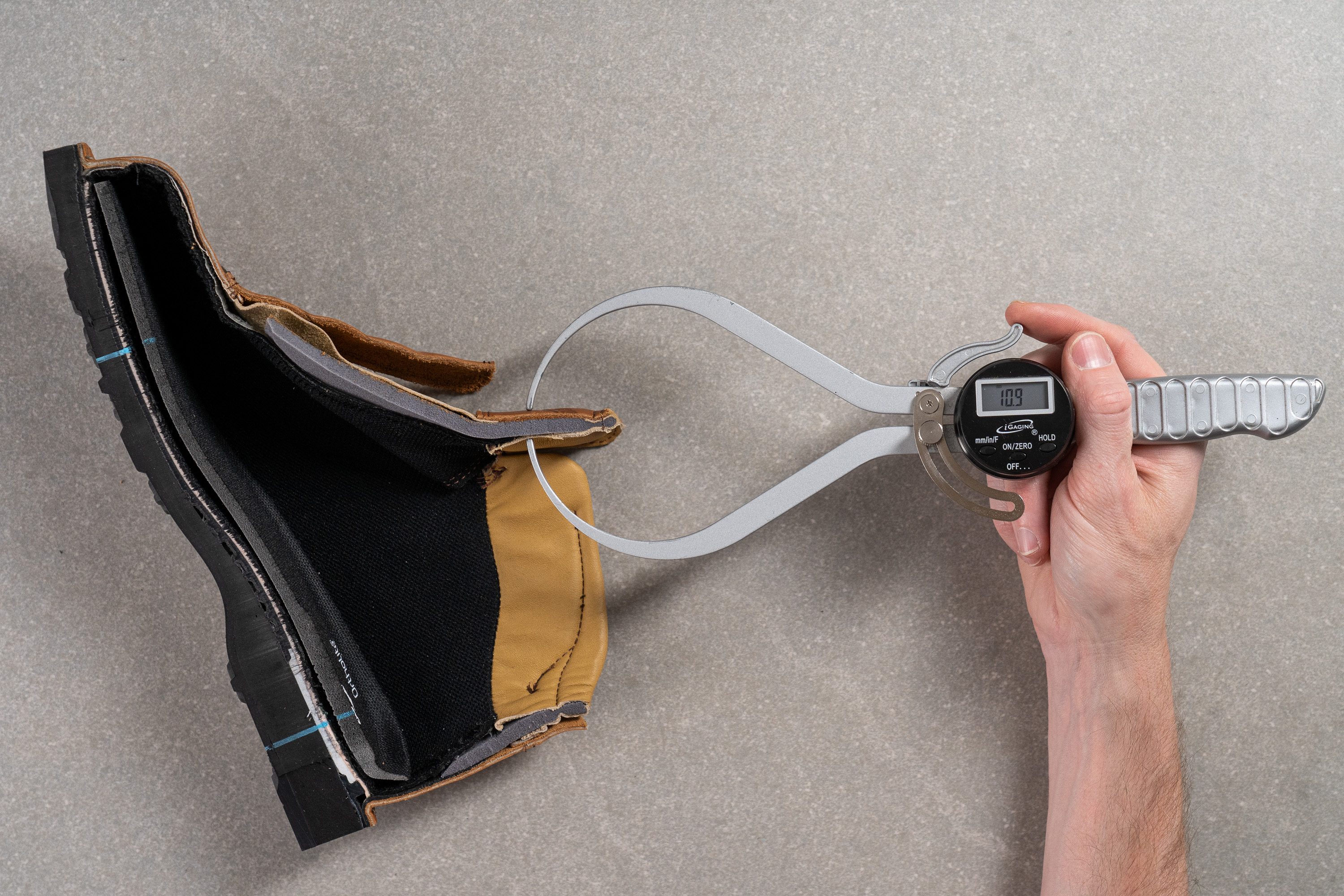
| Mountain Pass | 10.9 mm |
| Media | 11.2 mm |
Lengüeta: tipo de refuerzo
Igual que las demás botas Danner, las Mountain Pass tienen una lengüeta reforzada.
Pero espera, porque aún hay más: viene con un revestimiento de cuero extra que cubre todo el empeine, haciendo que la sujeción del pie sea incluso más segura. Además, también ayuda a que entren piedrecillas, agua o tierra dentro de las botas.

| Mountain Pass | Ambos lados (completo) |
Tirador del talón
Estas Danner tienen un tirador de cuero en la parte de atrás que hace que calzarse sea más fácil.
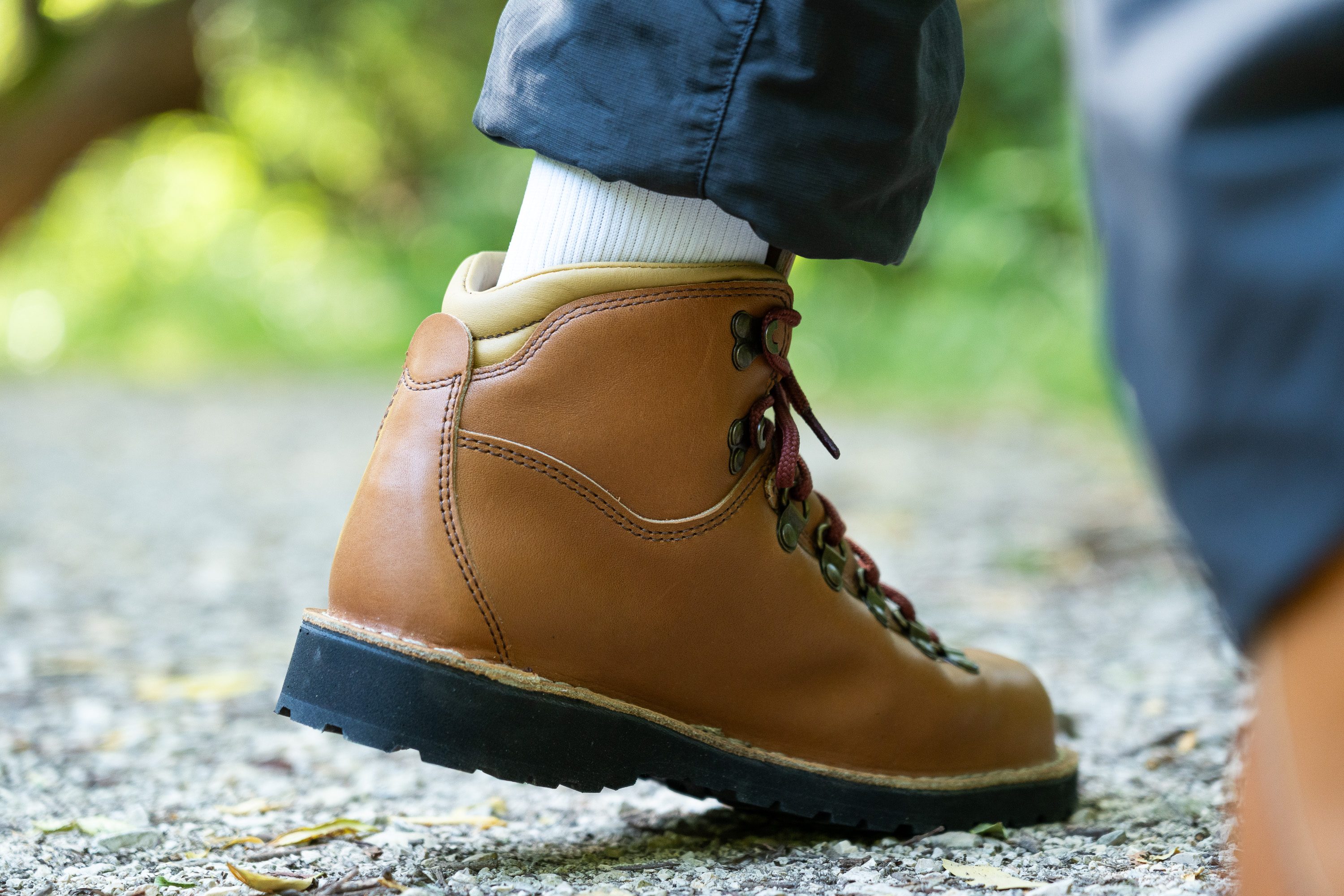
| Mountain Pass | Tirador estándar |

